

SUSTAINABLE AGGREGATE

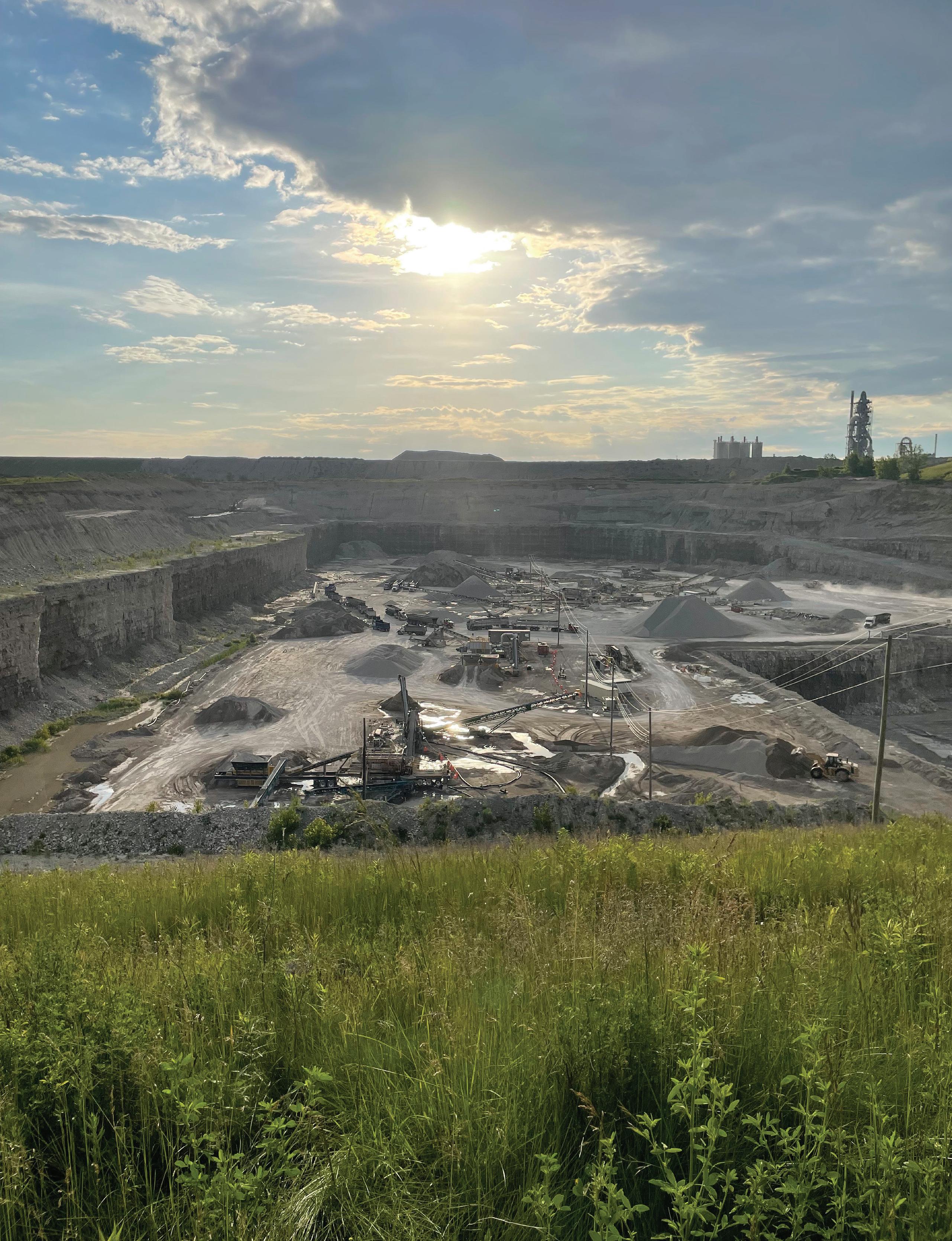

Why we need to do better



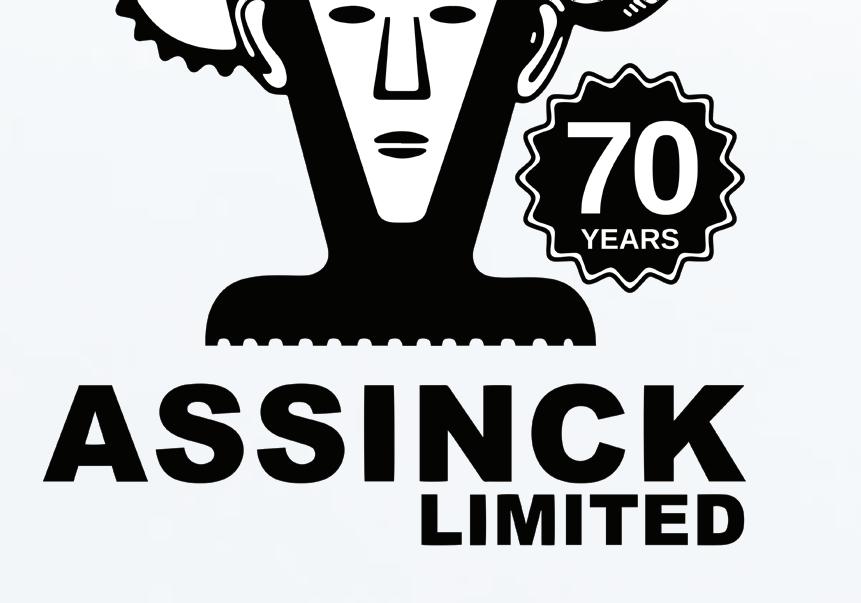




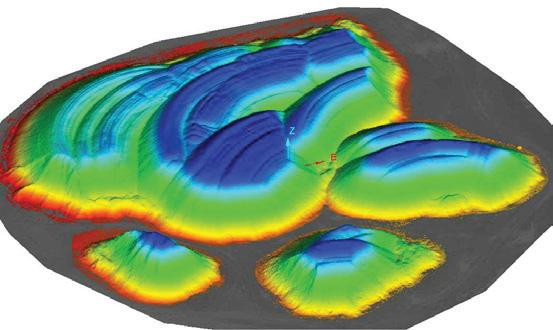

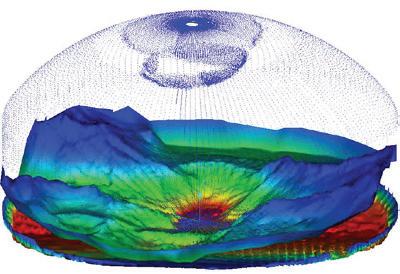

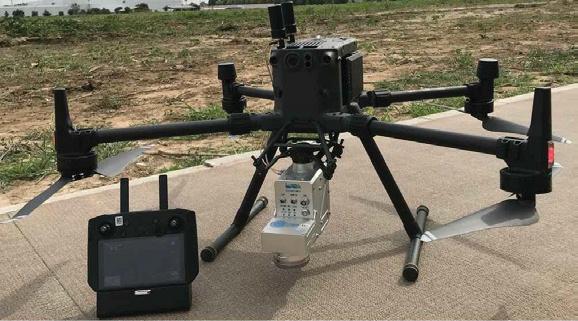
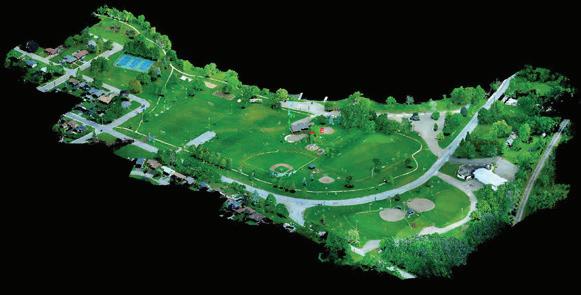

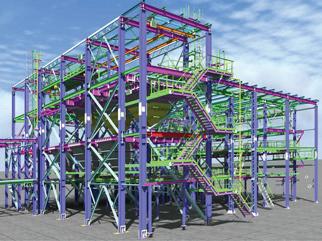



TEC TEC TEC
AERIAL


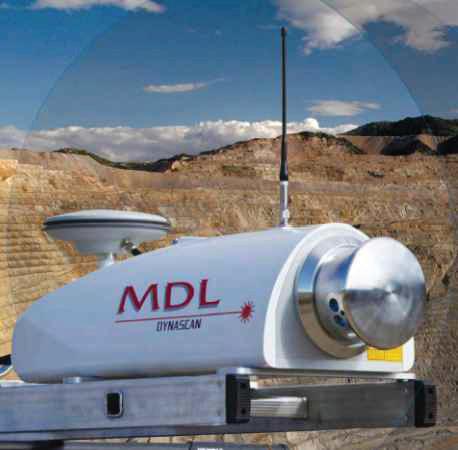



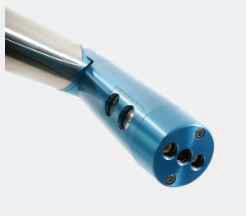

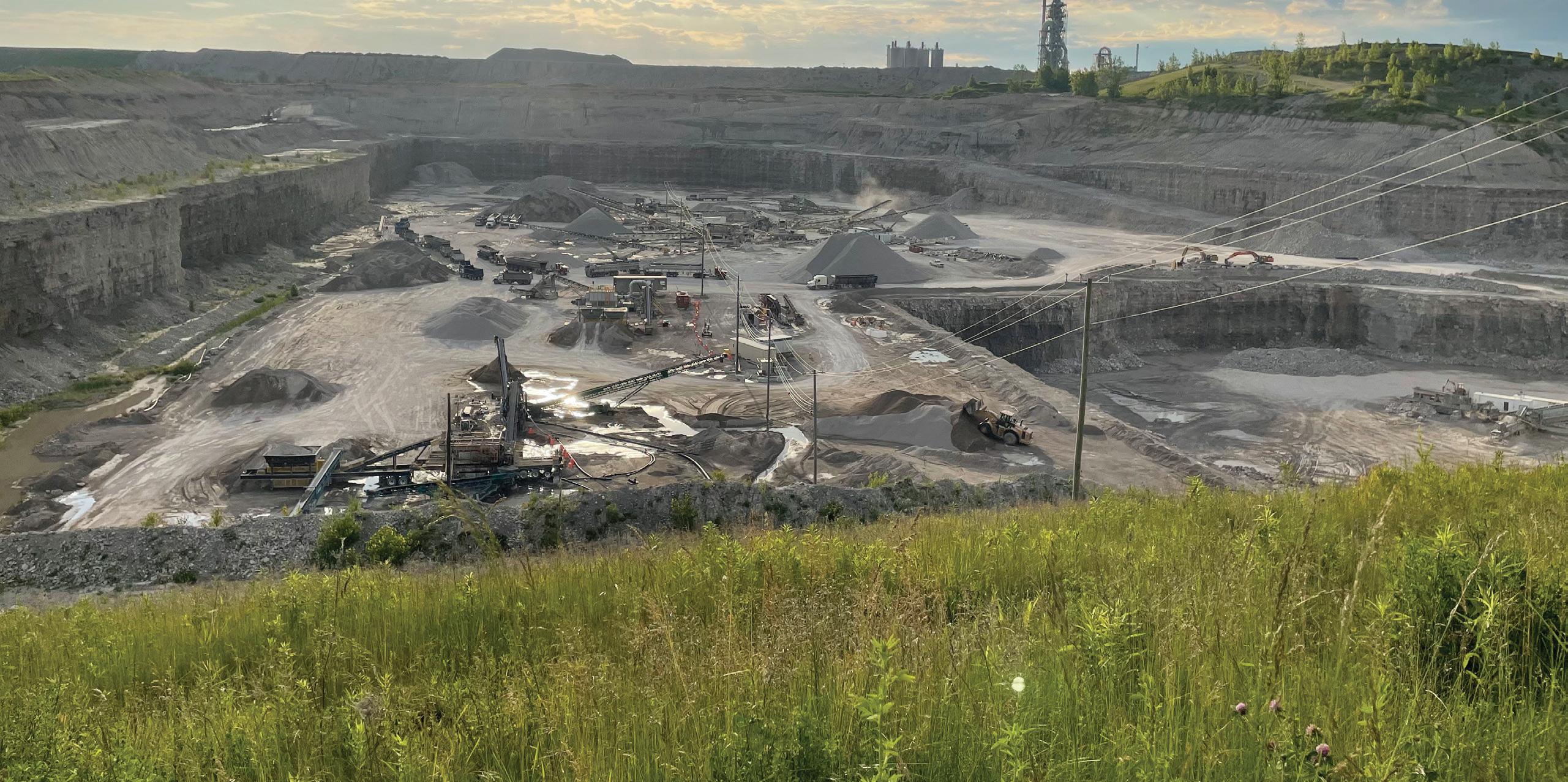
MATTHEW BRADFORD

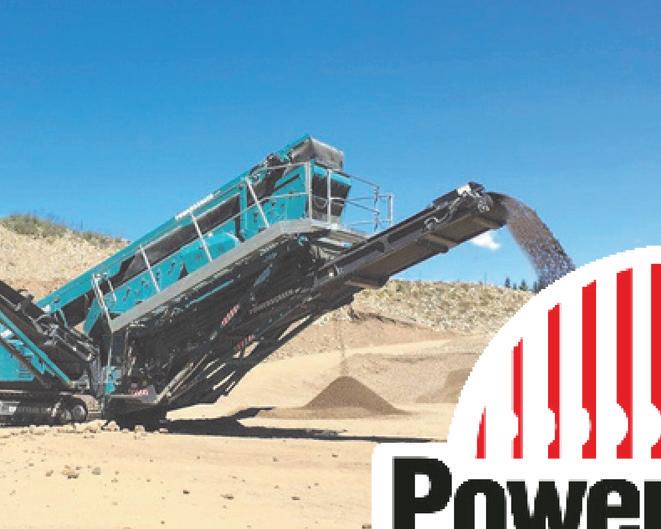
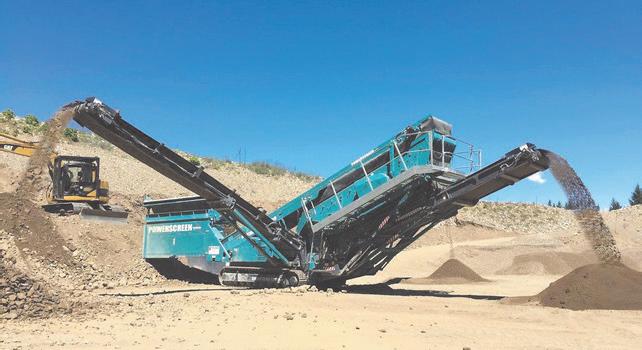



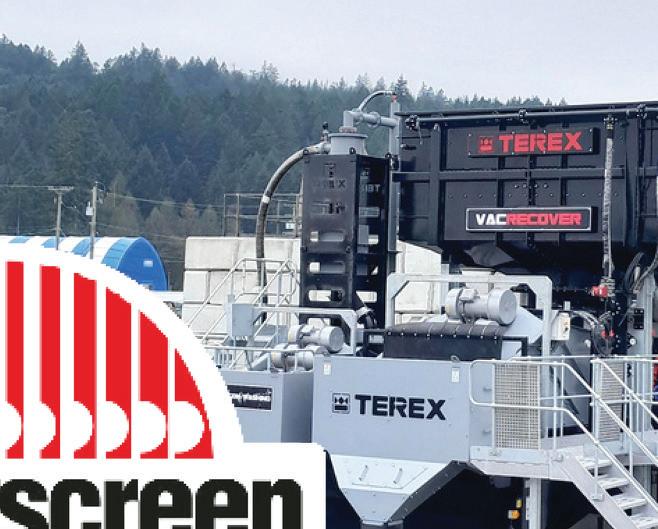



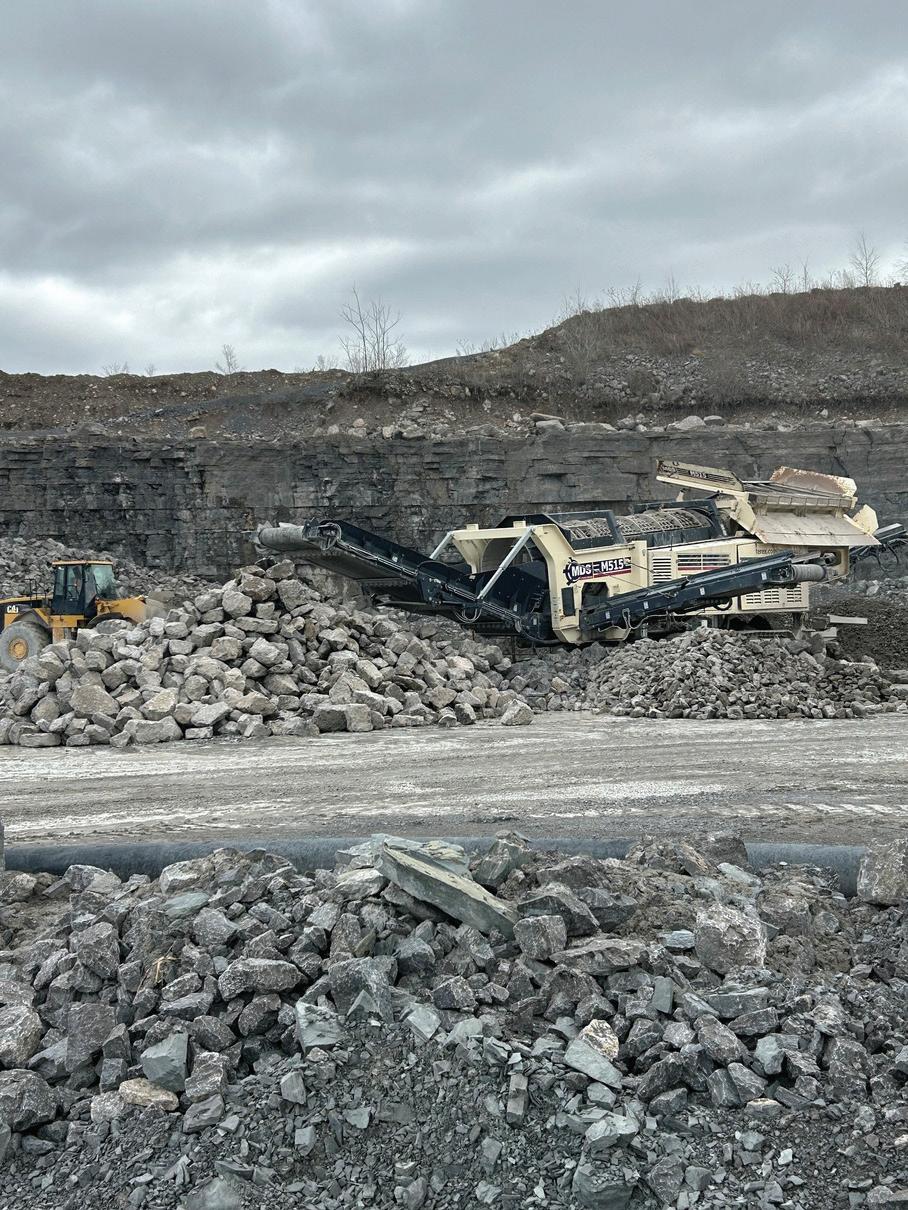





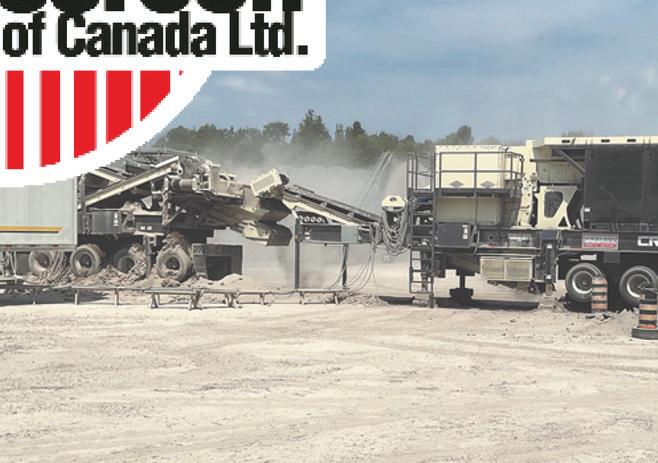

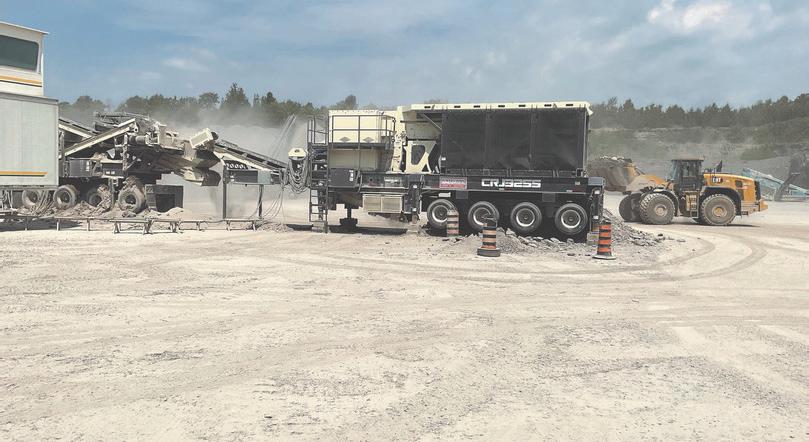







Collaboration, clarity and commitment: Building Ontario’s future together

In uncertain economic times, collaboration is more than a guiding principle; it’s a necessity. Across Ontario’s infrastructure sector, we face shared challenges. That’s why a united message, delivered by many voices, is essential to ensuring our industry is heard and understood by all.
Over the past 18 months, OSSGA’s board has developed and began to execute a strategic plan rooted in collaboration. A key step in that journey was our move into the “Roadhouse,” where we now share office space with the Ontario Road Builders’ Association (ORBA). With 75 per cent of our members overlapping, this move reflects our shared goals and strengthens our ability to work together.
That spirit of partnership has already led to meaningful joint initiatives, including Lobby Day 2025, the Association of Municipalities of Ontario (AMO) Infrastructure Industry Reception and the upcoming Fall Gala. These events demonstrate the power of coordinated advocacy. Looking ahead, OSSGA and ORBA’s executive committees will meet to explore new opportunities for collaboration and to ensure our efforts are aligned.
At the same time, we must work to build clear, distinct brands for the key areas of infrastructure in Ontario, including asphalt, aggregate and road building. While these sectors often operate under the same umbrella, they each play a unique role in Ontario’s infrastructure landscape. By clarifying our identities and speaking with a single amplified voice, we can better address all levels of government and advocate more effectively for the resources and recognition our members need.
Raising the profile of the aggregate industry has been a personal priority. Over the past year, I’ve attended many meetings at Queen’s Park, engaging directly with the premier, ministers and other senior officials. My message has been consistent: investing in infrastructure benefits us all, and stone, sand and gravel are essential to doing so. From roads and homes to schools and hospitals, our materials form the foundation of progress. Infrastructure investment is key to growth; not just economically but in the quality of life it supports.
As chair, I remain committed to collaboration and advocacy. By working together with our partners, clarifying our message and continuing to engage with government, we can position our industry for a stronger future Together, we will build Ontario, because nothing gets built in this province without stone, sand and gravel!
– By John MacKay, chair of the Ontario Stone, Sand & Gravel Association and president of Fowler Construction
Ontario Stone, Sand & Gravel Association
365 Brunel Rd., Suite 2
Mississauga, ON L4Z 1Z5
Tel: (905) 507-0711 www.GraveFacts.ca
Publishers
Michael McSweeney Executive Director
Sharon Armstrong Vice-President, Industry and Stakeholder Relations
Editor Andres F. Ibarguen Senior Manager, Communications
Sales Executive Sharon Headley
Designer Katrina Teimo
All rights reserved. The contents of this publication may not be reproduced by any means, in whole or in part, without the prior written consent of the association.
Published September 2025
PUBLICATION MAIL AGREEMENT #40787580
Please return undeliverable items to: Ontario Stone, Sand & Gravel Association
365 Brunel Rd., Suite 2 Mississauga, ON L4Z 1Z5
Advocacy with purpose: Strengthening Ontario’s aggregate future
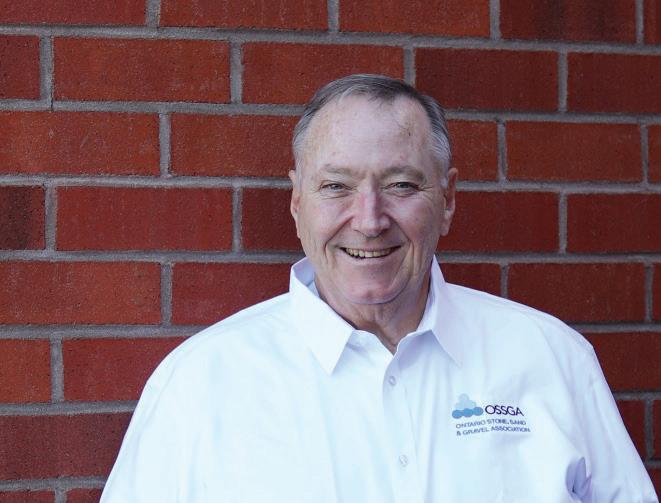
BY MICHAEL MCSWEENEY, EXECUTIVE DIRECTOR, OSSGA
Advocacy isn’t just about being heard; it’s about being understood. And in today’s climate, clarity and connection are more important than ever. As Ontario navigates economic uncertainty, shifting political priorities and growing infrastructure demands, OSSGA remains focused on strategic advocacy that protects our industry and supports the province’s long-term growth.
Digging into OSSGA’s advocacy priorities
Our work is grounded in these key priorities: strengthening municipal relations, improving licensing timelines, building genuine partnerships with Indigenous communities, developing more sustainable operations and aligning with provincial and federal objectives. Each of these areas is critical to ensuring Ontario has the aggregate resources it needs to build homes, roads, schools and transit systems for generations to come.
One of the most pressing challenges we face is the growing tension between municipal and provincial jurisdictions. OSSGA continues to advocate for municipalities to follow the Provincial Planning Statement and the Aggregate Resources Act, rather than rewriting zoning bylaws and official plan amendments that are already covered under provincial legislation.

Recent cases in Caledon and Muskoka Lakes have raised serious concerns. These local amendments not only contradict provincial policy, they risk setting a dangerous precedent. If allowed to stand, they could trigger a domino effect across Ontario, making it increasingly difficult to establish new quarries or extend existing leases.
Municipalities should be protecting aggregate to build their communities, not standing in the way of growth. The province must step in to clarify jurisdictional boundaries and ensure that local governments are not obstructing development that aligns with provincial priorities. Sending every dispute to the Ontario Land Tribunal is inefficient and delays critical infrastructure projects by restricting access to important raw materials. We need a more streamlined, cooperative approach that respects both local input and provincial authority.
We continue to have a strong focus on happenings at Queen’s Park and have been actively engaged with the premier and the minister of natural resources with the objective of introducing new legislation to shorten the timeline for aggregate licensing from seven to 12 years to three to five years. This is a top priority for us as the lengthy time it takes to license a new aggregate site
directly impacts taxpayers by raising the cost of raw materials used in essential infrastructure projects such as new hospitals, roads and community centres.
Anticipating demand decades ahead and ensuring it’s close-to-market
Aggregate is an industry that plans decades ahead, not just from the perspective of licensing but also when analyzing future aggregate demand. Environmental groups often argue there’s no shortage of aggregate in Ontario. But what they fail to consider is the timeline. Aggregate companies acquire land 25 to 50 years in advance to ensure future supply. There may be no shortage in 2025, but in the context of future demand there is certainly a shortage.
We will continue to work closely with government to ensure that the licensing process is efficient, transparent and responsive to Ontario’s growing infrastructure needs.
Ontario’s population has almost doubled in the last 40 years, and the demand for infrastructure has grown with it. Yet, aggregate resources are increasingly located far from the urban centres where they’re needed most. There are no significant aggregate deposits south of Highway 401 in the Greater Toronto Area, meaning materials must be hauled from further afield – often through the heart of the city.
This has serious cost implications. Aggregate is heavy and transportation is expensive. Sourcing close to market saves money, reduces emissions and benefits taxpayers. Roughly 60 per cent of aggregate goes to infrastructure projects, while 40 per cent supports residential construction. Both are essential to Ontario’s growth.
Christie Pits offers a compelling example of how aggregate development can evolve. Once a sand pit on the outskirts of the city, as the city grew around it the site was transformed into a public park. Many former pits now sit unnoticed at the centre of urban communities –proof that thoughtful planning can serve both development and public use, and a reminder that we need not fear close-market aggregate. How many aggregate sites that were once close to Toronto are now virtually unrecognizable?
We can only develop where the resources exist. That’s why OSSGA continues to advocate for policies that support close-to-market aggregate extraction and long-term supply planning.
Prioritizing Indigenous relations and sustainability
Finding a balance between extraction, sustainability and land protection is also vital to our efforts. OSSGA recognizes the importance of engaging with Indigenous communities respectfully and meaningfully. We spend time learning about Indigenous cultures, meeting with leaders and encouraging participation in the development process to ensure that they are properly compensated for aggregate extraction. We’re also seeing more and more aggregate companies enter into long-term economic agreements with Indigenous communities directly
PUBLIC SENTIMENT IS SHIFTING. RECENT POLLING SHOWS THAT A MAJORITY OF CANADIANS SUPPORT PRIORITIZING ECONOMIC GROWTH INITIATIVES AND “FAST-TRACKING” DEVELOPMENT PROJECTS.
Christie Pits offers a compelling example of how aggregate development can evolve. Once a sand pit on the outskirts of the city, as the city grew around it the site was transformed into a public park.
These partnerships are about more than compliance – they’re about shared prosperity. OSSGA is committed to building genuine relationships that honour Indigenous rights and contribute to sustainable development across Ontario. Doing so from a place of understanding, humility and sustainability. We want to see the aggregate industry continue to contribute to the growth and betterment of society – and that means doing so in a way that is sustainable over time.
Both the provincial and federal governments have introduced new legislation aimed at accelerating housing and infrastructure development. OSSGA supports these efforts and continues to work with policymakers to ensure aggregate supply is part of the conversation.
Public sentiment is shifting. Recent polling shows that a majority of Canadians support prioritizing economic growth initiatives and “fast-tracking” development projects. This underscores the urgency of our work and the importance of balanced, respectful development.
We must ensure that infrastructure investments are not delayed by outdated processes or jurisdictional confusion. OSSGA is committed to working with all levels of government to streamline approvals and support Ontario’s growth.
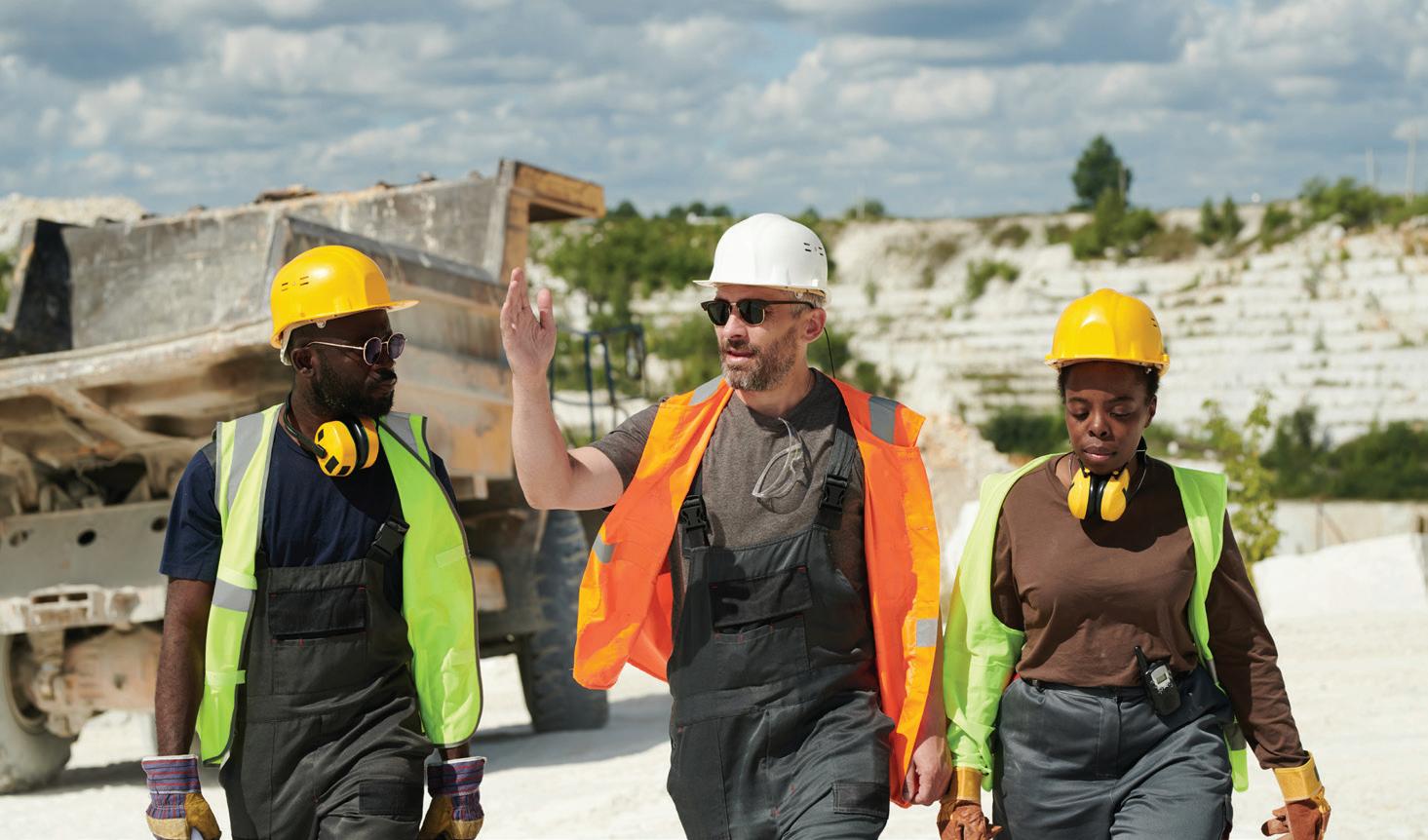
The foundation of a comprehensive advocacy strategy
Our advocacy is rooted in clarity, respect and long-term vision. Whether it’s working with municipalities, reforming licensing timelines, planning for future supply or building Indigenous partnerships, OSSGA is focused on ensuring Ontario has the resources it needs to thrive.
We call on our members to stay engaged, informed and active in their communities. The challenges we face are real, but so are the opportunities. With strategic advocacy and strong collaboration, we can build a future that benefits all Ontarians.
Our work today lays the foundation for the roads, homes and communities of tomorrow. Let’s build that future with clarity, respect and purpose.
Both the provincial and federal governments have introduced new legislation aimed at accelerating housing and infrastructure development. OSSGA supports these efforts and continues to work with policymakers to ensure aggregate supply is part of the conversation.



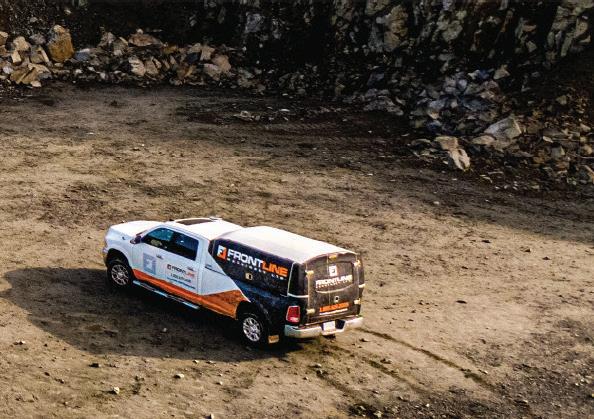

inventory includes over $23 million in parts, with 9,000+ in-stock numbers from 300+ trusted vendors.
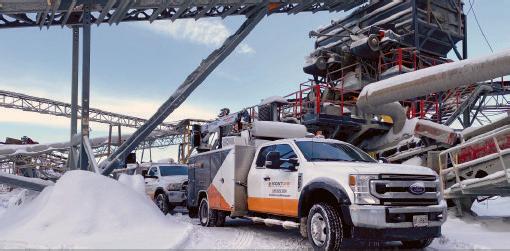
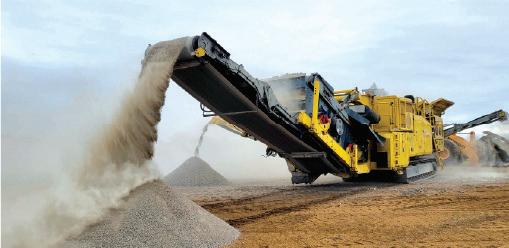

BY MATTHEW BRADFORD
Canada’s mission is clear: build big, build bold and build now. It’s a rallying cry heard across the country as governments and industries fast-track efforts to strengthen the economy and expand Canada’s global market footprint. The desire to build is strong, but as always, Canada’s progress depends on the steady –and sustainable – supply of aggregate.
Ontario’s sand, stone and gravel producers are central to this mandate. Collectively, they supply over 160 million tonnes of aggregate annually to fuel essential infrastructure: roads, transit systems, housing, hospitals, schools and countless other projects. The challenge isn’t simply to produce the material needed to build this critical infrastructure, but to do so cleanly, responsibly and in ways that safeguard the environment and the long-term success of the industry.
Fortunately, sustainability is already a priority in Ontario’s aggregate sector. Producers throughout OSSGA's membership have embraced practices that prioritize recycling, land rehabilitation, clean energy and operational efficiency. These efforts are reshaping the industry while setting an important precedent for how resource extraction can coexist with environmental stewardship and community well-being.

The critical role of clean energy
Clean energy is one of the pillars of sustainability in aggregate production. Traditionally, quarries relied heavily on diesel-powered equipment and electricity generated from fossil fuels, resulting in the production of greenhouse gases (GHGs). Today, however, more and more are investing in shifts toward renewable sources like solar, wind and hydroelectric power to keep their operations running.
Ontario is well positioned for this transition thanks to an electricity grid that is already largely decarbonized. More than 80 per cent of the province’s power generation comes from non-emitting sources such as nuclear, hydro, solar and wind. Producers that connect to this grid gain the ability to run cleaner operations simply by electrifying more of their equipment and processes. The growing adoption of electric-powered crushing and screening equipment is significantly reducing GHG emissions, improving air quality and lowering long-term energy costs.
On-site renewable generation is another movement in a cleaner direction. In some instances, solar arrays are being installed on quarry lands or rooftops to provide a portion of the power needed for operations, while battery storage systems are being installed to capture the energy generated by solar arrays to help manage peak demand.
All told, by embracing clean energy, Ontario’s aggregate sector demonstrates environmental leadership, strengthens relationships with host communities and contributes to the province’s transition toward a low-carbon economy – all while continuing to supply the materials essential to Canada's growth and prosperity
A clean energy case study: Amrize's Woodstock Quarry
Clean energy success stories can be found throughout the aggregate sector. In Ontario, many members of OSSGA are making bold moves to reduce emissions and improve energy efficiency. A standout example is Woodstock Quarry, operated by Amrize Canada (previously known as Lafarge Canada).
Located in Zorra Township, this site recently launched a $1 million clean energy initiative aimed at reducing reliance on fossil fuels and optimizing operations. The project involved transitioning one of the quarry’s plants from diesel generator power to Ontario’s clean electricity grid. This required extending hydro infrastructure from 33rd Line into the quarry, as well as installing two transformers to support three plants. The result, says Shea Burns, plant manager for Woodstock Quarry, is reliable, cleaner energy for ongoing operations. “We’re always looking at ways we can be more innovative and sustainable, and the last thing we want to do as we grow is bring in more generators and use more fuel”
We’re always looking at ways we can be more innovative and sustainable, and the last thing we want to do as we grow is bring in more generators and use more fuel.
BY EMBRACING CLEAN ENERGY, ONTARIO’S AGGREGATE
SECTOR DEMONSTRATES ENVIRONMENTAL LEADERSHIP, STRENGTHENS RELATIONSHIPS WITH HOST COMMUNITIES AND CONTRIBUTES TO THE
Woodstock Quarry's initiative is expected to eliminate up to 1,460 tonnes of CO₂ emissions annually while boosting plant efficiency and reliability. A few months ago, Amrize Canada highlighted the project’s impact on social media, stating: “We’re reducing our environmental impact, one quarry at a time! Across Eastern Canada, we’re changing the way our quarries operate by moving away from diesel generators to electrical power, and the results speak for themselves.”
With this milestone achieved, Burns says the quarry is now exploring ways to extend line power to its last generator-powered plant. “We have one more plant that still runs on a generator, and we hope to transition that soon,” she notes.
Beyond clean energy
Amrize’s Woodstock Quarry’s sustainability journey does not stop at electrification. The site has also invested in upgrading its fleet of machinery, replacing aging loaders with newer, more efficient models that reduce fuel consumption while enhancing performance. “Our oldest loader now dates back to 2022,” Burns says, underscoring the company’s commitment to keeping equipment modern and efficient.
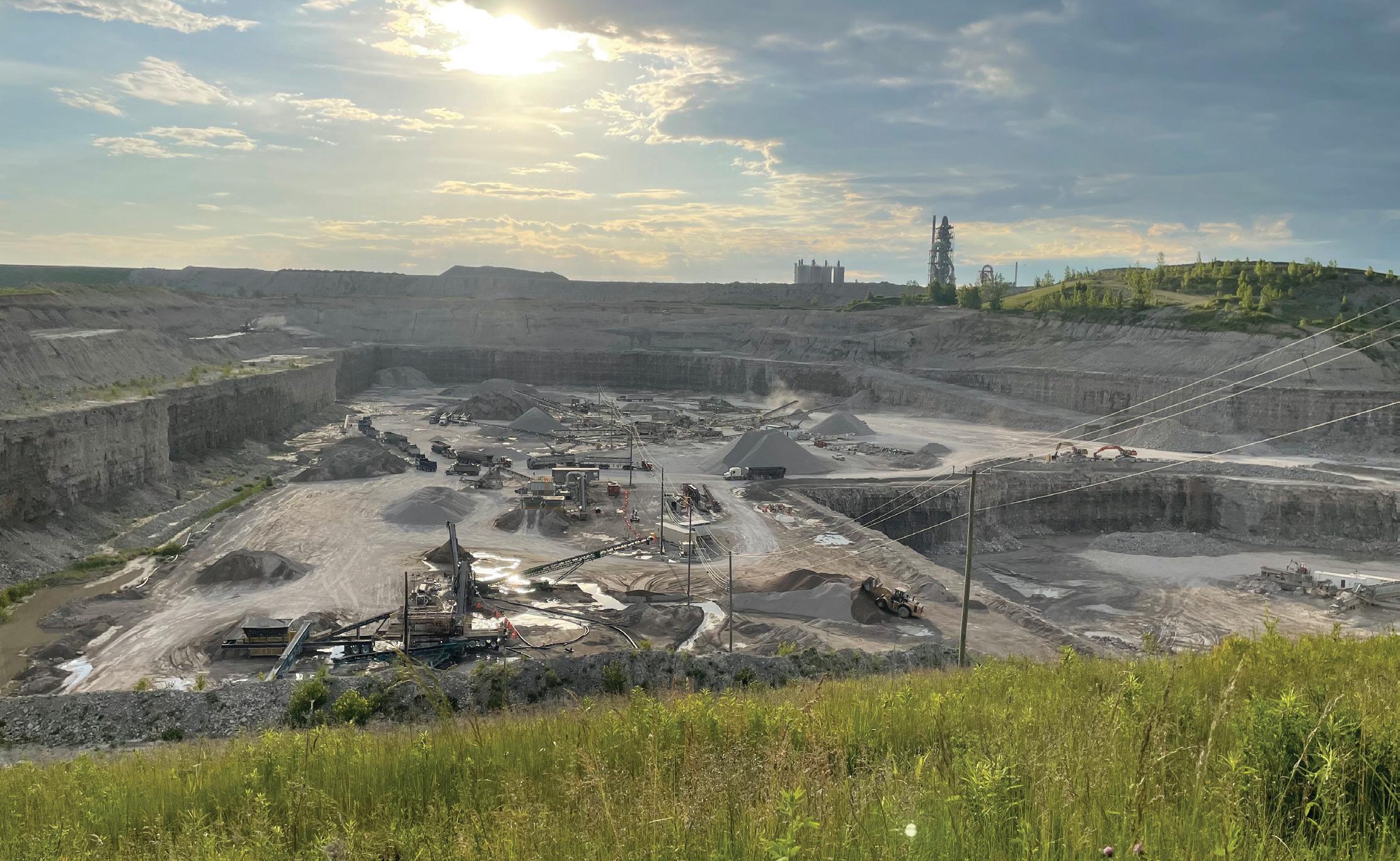
SUSTAINABILITY IN THE AGGREGATE INDUSTRY TAKES MANY FORMS, EACH CONTRIBUTING TO A MORE RESPONSIBLE AND RESILIENT FUTURE.
Responsible land stewardship is another cornerstone of Woodstock Quarry’s operations. The site has earned multiple awards from OSSGA for its commitment to progressive rehabilitation across its 550-hectare property. Rehabilitation work is often quiet, ongoing and unglamorous, but as Burns explains, “It’s not highly visible work, but it’s some of the most important work we do.” The team’s on-site innovation and sustainability practices are complemented by its strong community engagement program, including support for local initiatives, open houses to drive public awareness and donations of time and resources to organizations such as the local women’s shelter and youth sports groups.
The quarry’s sustainability efforts reflect those being undertaken by aggregate producers across Ontario. Together, these initiatives highlight the industry’s recognition that long-term viability depends on trust, transparency and a shared commitment to environmental responsibility. “We’re building toward something that’s more efficient, more responsible and better for the community,” says Burns. “It’s not just about what we take out of the ground — it’s about how we operate while we’re here.”
Many paths to sustainability
Sustainability in the aggregate industry takes many forms, each contributing to a more responsible and resilient future. Beyond
BEYOND CLEAN ENERGY
UPGRADES, ONTARIO PRODUCERS ARE ADOPTING SEVERAL BEST PRACTICES THAT ARE RESHAPING THE SECTOR.
clean energy upgrades, Ontario producers are adopting several best practices that are reshaping the sector.
One of the most impactful strategies is the increased use of recycled materials, such as recycled asphalt pavement and recycled concrete aggregate. Rather than relying solely on new extractions, producers and municipalities are increasingly recovering and repurposing material from road reconstruction, demolition and other sources for use in new projects. This practice reduces waste, conserves natural resources and often lowers emissions by shortening transport distances.
Ontario’s technical standards support the use of recycled aggregate, and volumes are steadily rising as a result. This shift prevents millions of tonnes of material from ending up in landfills and
We’re building toward something that’s more efficient, more responsible and better for the community,” says Burns. “It’s not just about what we take out of the ground — it’s about how we operate while we’re here.
Woodstock quarry’s legacy
Since the 1950s, Amrize’s Woodstock Quarry has been a cornerstone of infrastructure development in southwestern Ontario. Spanning 550 hectares, its limestone aggregate is prized for its quality and has supported major regional projects. Among its most notable contributions:
• Supplied 1.2 million tonnes of aggregate for a major battery plant project.
• Played a role in constructing the Amazon fulfilment center in London, Ontario.
• Provided materials for upgrades to Highway 401 and Highway 402.
The quarry's legacy underscores the enduring importance of aggregate to Ontario’s growth and the site's role in balancing economic contributions with environmental responsibility.
BUILD YOUR AMBITION WITH US
reduces pressure on new extraction sites. While challenges remain in boosting market acceptance, attitudes are evolving as the benefits become clearer.
Progressive rehabilitation is another cornerstone of sustainability. The goal is not only to restore land but to enhance it by creating wetlands, forests, green spaces or farmland that can support wildlife and benefit communities. Rehabilitation plans are required under Ontario’s Aggregate Resources Act, which ensures that land is not left disturbed for decades. Industry-led initiatives, like OSSGA’s Progressive Rehabilitation Award, further encourage innovation and recognize leadership in this area.
The provincial government also supports these efforts through the Management of Abandoned Aggregate Properties program, funded through the Ontario Aggregate Resources Corporation, which rehabilitates legacy or surrendered sites that predate modern regulation.


Amrize is the partner of choice for the professional builders of North America, covering every project need from foundation to rooftop. With over 1,000 sites, 19,000 teammates, and a highly efficient distribution network, we deliver advanced building solutions for infrastructure, commercial and residential projects in every U.S. state and Canadian province. We are ready to build your ambition.
Regent Park Tower Toronto, ON
A new chapter for Amrize Canada
By Matthew Bradford
On June 23, 2025, Lafarge Canada, Holcim US and Holcim Building Envelope completed their transformation into Amrize after spinning off from Holcim Group to become an independent, publicly traded company with a new name and a North American focus.
"As an independent, publicly traded company, Amrize will capitalize on North America's attractive construction market driven by longterm mega-trends from infrastructure modernization and onshoring of manufacturing to data center expansion and the opportunity to bridge the housing gap," announced Jan Jenisch, Amrize Chairman and CEO. "It has been a privilege to be part of Holcim since 2017, and I thank the entire Holcim team for their outstanding performance and contributions over the years, including the exceptional execution of our spin-off, creating two distinct, independent champions."
Amrize’s name signals the rebranded company’s “ambition” to “rise” in its new independent venture, with “Am” representing the company’s commitment to delivering high-performance and innovation solutions to its customers and “Rize” symbolizing its drive to “lead construction forward across North America and shape the essential buildings and infrastructure that advance how people live.” The company launched under the ticker symbol AMRZ on both the New York Stock Exchange and the SIX Swiss Exchange, with new executive leadership and a capital structure as an independent, publicly traded company.
“This is an exciting time for construction in North America, with the ongoing modernization of infrastructure, the reshoring of manufacturing and the opportunity to bridge the housing gap with the most advanced building solutions,” Jenisch said in the company’s press release. “With our planned spin-off of Amrize, we aim to be the partner of choice for our North American customers and unlock value for all our stakeholders.”
With over 1,000 sites and a highly efficient distribution network, the company delivers for its customers in every Canadian province and U.S. state. Amrize employs a team of over 19,000 professionals serving all corners of the market, from infrastructure, commercial and residential to new build, repair and refurbishment.

The rippling impacts of cleaner industries
The impacts of sustainable practices extend far beyond quarry gates. Recycling aggregate reduces the carbon footprint of long-haul trucking, extends the lifespan of finite natural deposits and decreases the need to open new extraction sites – all while helping avoid land-use conflicts with nearby communities. Meanwhile, progressive rehabilitation produces visible, long-term benefits such as improved water quality in wetlands, restored habitats for birds and pollinators and accessible green spaces that improve community well-being. Moreover, many of these projects are developed in partnership with conservation authorities, municipalities and environmental organizations to serve broader public goals, such as stormwater management or ecosystem restoration.
Just as importantly, sustainability builds trust. Considering aggregate is extracted close to where people live – particularly in growing urban and suburban regions –producers must demonstrate transparency and responsibility. Proactive community engagement, regulatory compliance and consistent communication help maintain the industry’s “social licence” to operate. And in the end, communities are more likely to support projects when they see producers investing in clean energy, rehabilitation and local initiatives.
Sustainability is a journey
Ontario’s sand, stone and gravel industry is embedding sustainability into its DNA because the stakes are high. Aggregate is non-renewable, and infrastructure demands are only expected to grow alongside population and economic expansion. With proper management, the sector can be a leader in sustainability, turning rehabilitated lands into ecological assets, reducing emissions through clean energy and supporting local communities through engagement and investment.
WHEN TIME RUNS OUT: HOW LONG IT REALLY TAKES TO GET AN AGGREGATE LICENCE IN ONTARIO
BY OSSGA STAFF WRITER
In the world of aggregate licensing, the numbers tell a story, and it’s not a particularly hopeful one.
Ontario’s pits and quarries are the foundation of our roads, homes and infrastructure. But the process to approve new aggregate licences has slowed to a crawl, placing enormous strain on the supply chain that underpins development across the province. OSSGA has been tracking the data, and what we’re seeing is deeply concerning: we are surrendering sites faster than we are approving new ones and licence approvals are taking longer and longer, with no signs of improvement.
A shrinking pipeline
Between 2019 and 2023, Ontario approved just 84 new aggregate licences. In the same period, 190 sites were surrendered, and only 57 new applications were submitted. We’re surrendering sites at a rate of more than 2:1. The math isn’t complicated; Ontario is not replenishing its supply of close-to-market aggregate, and that has far-reaching consequences for infrastructure projects, housing development and economic growth.
The average annual number of approved licences dropped from 22 between 2014 and 2019 to just 14 between 2020 and 2024. And where those licences are located matters. From 2014 to 2019, new sites were more broadly distributed across the Greater Toronto and Hamilton Area and surrounding regions. But the few approvals issued since 2020 are increasingly farther from market, driving up transportation costs, increasing greenhouse gas emissions and putting more trucks on Ontario roads.
How long is it taking?
In 2014, 78 per cent of aggregate licences were issued within two years of their Environmental Registry of Ontario posting. By 2018, that figure had dropped to 50 per cent. In 2024, it sits at just 28 per cent.
Worse still, dozens of applications remain outstanding for years. OSSGA’s analysis found that 88 licence applications currently remain unresolved on the registry, including some dating back to

2016 — eight years without a decision. The Ministry of Natural Resources acknowledges it is currently managing 94 open applications.
The industry is also seeing a troubling pattern: the few applications that are being approved tend to be newer and presumably less complex. While this might be encouraging at first glance, it actually masks a backlog of older, more difficult files that continue to sit in limbo.
What’s behind the bottleneck?
Several factors have contributed to the growing delays in aggregate licensing:
• The 2017 Aggregate Resources Act amendments: While these changes modernized parts of the process, they also created complexity and uncertainty as both industry and ministry staff adapted.
• The Hayes decision (2017): This landmark court ruling determined that the Crown had not properly discharged its duty to consult with Indigenous communities before approving an aggregate licence. Since then, applications requiring consultation have often stalled at stage 4 of the licensing process, awaiting confirmation that the duty to consult has been fulfilled.
• COVID-19: Like many sectors, the pandemic disrupted operations, slowed inspections and compounded already significant delays.
• Organizational changes at the ministry: The launch of the Integrated Aggregate Operations Section (now simply the Aggregate Section) just before the pandemic created internal staffing and coordination challenges that took time to resolve.
OSSGA’s data analysis shows that, as of late 2024, 22 per cent of open applications are stuck at stage 4 due to incomplete consultation. Another 18 per cent are at stage 4 awaiting Ontario Land Tribunal proceedings. That means 40 per cent of all applications are effectively gridlocked before a licensing decision can even be considered.
Why this matters
The effects of this bottleneck are already being felt across Ontario. Fewer licensed sites mean longer haul distances, higher construction costs and mounting pressure on existing operations. Delays also create uncertainty for aggregate producers, municipalities and the development industry. Investors are discouraged, communities are frustrated and essential public infrastructure, from hospitals to highways face additional risks of delay or cost overruns.
But perhaps the most alarming takeaway is that Ontario’s future growth is being held back by a broken system. Without timely approvals, we cannot meet the province’s ambitious housing and infrastructure goals. We can’t build 1.5 million new homes without sand and gravel. And we can’t pave roads or repair bridges if the material to do it sits locked behind a multi-year bureaucratic process.
A call to action
The current data should serve as a wake-up call for both industry and government. OSSGA is actively engaging with the ministry and other stakeholders to share these findings and push for meaningful reforms. Among our top priorities:
• Streamlining the licensing process: Simplify and standardize timelines, especially for applications with minimal environmental or community impact.
• Supporting duty to consult: Establish clear protocols and resourcing to ensure consultation with Indigenous communities is conducted fairly, respectfully and efficiently.
• Improving transparency: Create public reporting mechanisms on application status, timelines and roadblocks to better inform industry and community stakeholders.
• Encouraging close-to-market approvals: Prioritize licensing decisions that support sustainable, lower-emission transportation distances.
• Stabilizing staff capacity: Ensure the Aggregate Section has the resources, training and continuity it needs to process applications effectively.
Looking ahead
At OSSGA, we’re committed to using data, not anecdotes, to tell the real story of our industry. Numbers don’t lie. And what they’re telling us now is that Ontario’s aggregate licensing system is not just inefficient — it’s unsustainable.
Without change, the delays will continue. The supply-demand imbalance will worsen. And communities across Ontario will pay the price.
But if we act now, if we bring government, industry and Indigenous partners to the table, we can build a system that protects the environment, respects communities and supports the essential materials needed to build a better Ontario.
Let’s not wait another eight years for the next licence approval.
At OSSGA, we’re committed to using data, not anecdotes, to tell the real story of our industry. Numbers don’t lie. And what they’re telling us now is that Ontario’s aggregate licensing system is not just inefficient — it’s unsustainable.

OSSGA AND ORBA MEMBERS
INTERVIEW ONTARIO’S MINISTER OF NATURAL RESOURCES MIKE HARRIS JR.
Members of the OSSGA and ORBA had the chance to interview Ontario’s Minister of Natural Resources Mike Harris Jr. while attending the AMO Conference in Ottawa in August. It was an excellent opportunity to share concerns, express support and discuss the importance of aggregate for Ontario’s future.Tha nk you, Minister Harris Jr.!
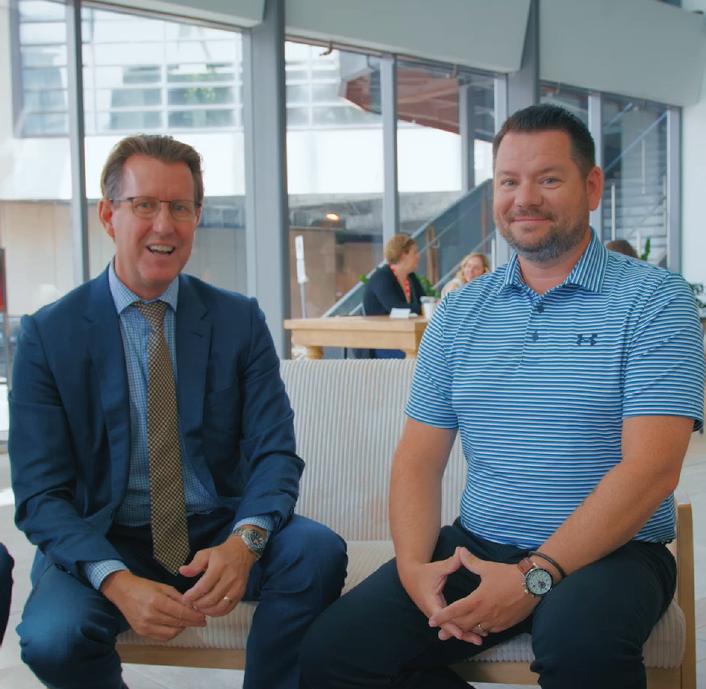
John MacKay (chair of OSSGA and president of Fowler Construction): So, we're here with Minister Harris. We appreciate your time today and we’re appreciative as an industry that we can meet and discuss issues. Hopefully you’re open to a few questions and we can pick your brain on a few ideas. We're really supportive of what the province is doing for development of infrastructure and the amount of spend you're going to have, as well as what the federal government is doing with their defense spending.Tha t's very attractive to us, and we're just kind of curious, from the Ministry of Natural Resources, how are you going to help us ensure that we will have the resources to complete these projects?
Minister Mike Harris Jr.: Yeah, I think when we look at the aggregate industry as a whole, obviously it's very, very signific ant to what we're doing with our infrastructure spend across the province. We're building highways, we're building schools, we're building roads, bridges, critical infrastructure and, obviously, with the defense spending that's coming out, we're going to need to improve a lot of our airports and a lot of the buildings that are in and around that. So, we'll be playing a big part. We want to make sure that we're doing everything we can to make it easier for the aggregate industry to flo urish, of course while still keeping a lot of those checks and balances in place that so many good operators like yourselves are already at the forefront of. And we're excited to partner with the industry and see where things go over the next little while.
Malcolm Croskery (chair of ORBA and president of Pioneer Construction): Touching on the great initiative you guys have with the mega projects and everything else. We're still the only province with a two-lane highway that runs part of the way across it. So, I think, from the perspective of Northern Ontario, we’d like to see more projects on Highway 69, more projects on Highway 117, the two-plus-one, all the aggregates –everything that goes with it, and the permitting – how we fast-track these things so that we can see them in the next little bit. Our industry has been struggling, and I think that a big infrastructure push, especially in the north, would really go well. I think just getting those projects to market would help us.
Minister Mike Harris Jr.: Well, it was really interesting. I actually just got back from Kenora last week and we flew into Winnipeg, and we're driving, and then as soon as you hit Ontario, you could see the start of the twinning of the highway, which is now a few kilometres down the road. So, it's good to see a lot of that happening. Obviously, my father, former premier Mike Harris, was a big proponent of that, the full twinning of the 469 all
OSSGA STAFF WRITER
John MacKay (left) and Mike Harris Jr. (right)
the way up to Sudbury. And there's still a lot of good work to go and continue with. I think we're in a good position to get a lot of these bigger projects across the finish line. I'm in a northern boy at heart, from North Bay, obviously. And I always kind of make the joke, you can take the boy out of the north, but you can't take the north out of the boy. So, I’m certainly familiar with a lot of the challenges that exist in Northern Ontario. And, of course, access to market up there is a big thing, right? Everything is so far apart. We need to be able to make sure that we're permitting, and we're doing everything in the most pragmatic way to try and get a lot of these areas closer to the job site. So, we want to make sure that there's open access to product and that we're don’t have to cart it halfway across the province. I think there's a lot of good things to come there. And you know, like you said, there's so many great projects that are on the board right now, I’m really excited to see a lot of them come to fruition over the next little while.
Malcolm Croskery: Our biggest slogan is, don't make gravel travel.
Minister Mike Harris Jr.: There you go, exactly
Mike Andrighetti (general manager of Ethier Sand and Gravel): Maybe I'll pivot now to a little bit about red tape, something I know that you're very familiar with. We feel that the aggregate industry is probably the most regulated industry in Ontario. We often work with multiple ministries for the same approvals. How is your office or maybe your government shortening that time and making it easier for an industry like ours to get permits and approvals through the door quickly?
Minister Mike Harris Jr.: Yeah, it's really an “all of government” approach. When we look at this, I think one of the things that premier Ford has been very, very adamant about is customer serv ice and making sure that we're not duplicating processes, making sure that when you're interacting with my ministry, with the Ministry of Natural Resources, that you don't have to then resubmit the same information to multiple ministries, and seeing everything in silos. So, one of the things that we're really trying to do from our side is make sure that we're sharing that information across ministries to make it easier for you. You don't need to have dedicated staff just to fill out forms and deal with overwhelming bureaucracy. And of course, as the former red tape reduction minister, I know we've had these conversations many times, I think there's been some good work behind the scenes that's done, and I think industry is going to be very happy with the level of customer service that they're going to receive over the next little while.
Mike Andrighetti: Great, awesome.
Dwayne McKenzie (general manager of Nelson Aggregate Co.): I was going to touch base on that with our core hearing, but I'll pivot to long-term. How do you envision sustainability of our aggregates in the local community so they don't have to travel? Do you have a long-term vision on that?
I think one of the things that premier Ford has been very, very adamant about is its customer service and making sure that we’re not duplicating processes.
- Minister Mike Harris Jr.
Minister Mike Harris Jr.: Yeah, we talk to municipalities a lot about what that's going to look like. Obviously, there are a lot of different municipal organizations that OSSGA and other aggregate companies have to deal with on a pretty regular basis. And what we're trying to do is start to get a little bit more information about what the municipal needs are going to be over the next little while, not just what's happening from a provincial standpoint. Because when we're looking at how many aggregate pits are in a certain area, or who's going to have some of these larger scale infrastructure projects from a municipal standpoint, then we can start to look at when we're permitting things. And when we're looking at areas that we would like to see develop more, then we're able to have that access to market close to where a lot of those projects are. I think a lot of the conversations that have been had over the years didn't necessarily bring a lot of that together. It was a lot of one offs and things like that. So, starting to try and almost asset map the way that municipalities are going to be pulling their infrastructure projects together over the next while. It makes a lot of sense.
John MacKay: Jumping on sustainability, what our associations are really focused on with the 444 different municipalities is having harmonized space, because on the recycling side, some municipalities don't recycle at all, whereas the province of Ontario is our leader in that, right? We'd like to see the province take a leadership role and bring the municipalities up so that they're not recycling differently.
Minister Mike Harris Jr.: Stay tuned on that one, stay tuned on that one guys.
Matthew Ruggieri (general manager, central aggregates at Amrize Canada): Maybe last technical question. You know you've been around four months now in the role and a lot of us had the pleasure of you coming out and visiting our sites. What's been your key takeaway, or key learning, from visiting aggregate producers across the province?
Minister Mike Harris Jr.: Yeah, I think one of the things that's really struck me is, is how much the operators care, how much they care about their sites, how much they care about the community.
And it's not just about extraction. It's also about how we're interacting with community, how we're making a community better. It's been really eye opening to see a lot of that, to be down right in and see a lot of the mitigation measures that great operators around the province are using and how they're interacting with community Obviously, we hear a lot about community. I come from one of the top aggregate producing ridings in the province, and it's just so great to see so many great operators out there just doing everything that they can to make sure that the community feels heard and involved, but also to be able to do the great things that we need to do here in the province. So, it's been a steep learning curve over the last little while but really enjoying it. And this ministry is phenomenal. It touches so manydiffer ent parts of the province and it's really great to be part of it.
Jim Petrella (general manager of Dufferin Aggregates): You’re new to the role, but not new to our industry. What do you think, given the climate today, should be one of our key areas of focus or priorities as an aggregate producer?
Minister Mike Harris Jr.: Yeah, well, we were just sort of talking about that, just saying that the interaction with community and the way that the great operators, producers out there are able to take stock in what's happening in and around the community, being able to liaise, being able to respond to questions, and just really keeping that dialog open. I think that's one of the biggest things that I hear as minister and as a local member of provincial parliament as well, that they just want to have that conduit, that they want to be able to

have that dialog back and forth and make sure that communities’ concerns are heard. But at the end of the day, we can't build if we don't have aggregate, right? It's super important. So, I think just keep up the good work. You know, the industry has been doing very well over the last little while. I'm hearing nothing but good things. And we've been out this summer, we've toured a few sites, and we're just kind of looking forward to getting back to Queen's Park in the fall and continuing to make the push to build Ontario.
John MacKay: We appreciate your time. I know it's valuable, so giving us a few minutes today is much appreciated.
Minister Mike Harris Jr.: No, no, it's my pleasure, guys, and you know what, to the industry as a whole, my door is always open for you.
It’s just so great to see so many great operators out there just doing everything that they can to make sure that the community feels heard and involved.
- Minister
Mike Harris Jr.
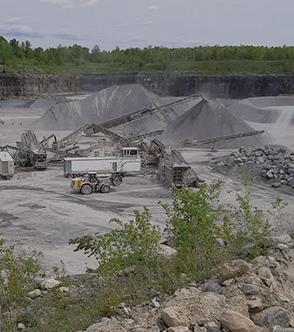




















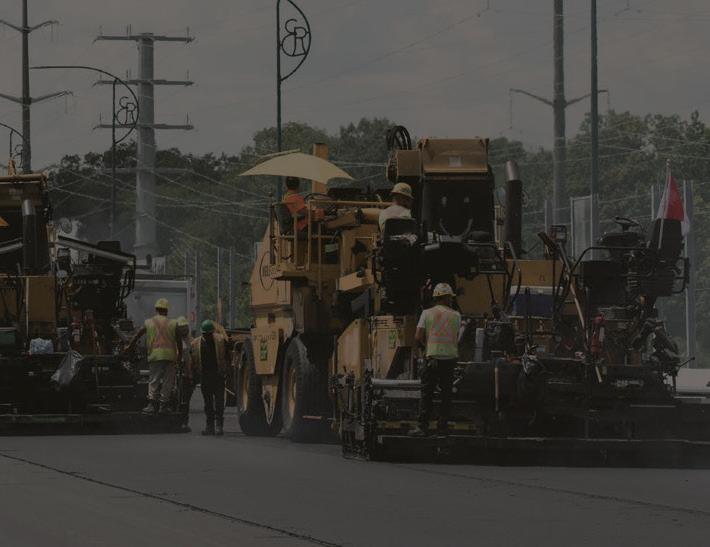

OSSGA AND OBRA PUSH FOR INFRASTRUCTURE REFORM IN JOINT LOBBY DAY
BY OSSGA STAFF WRITER
Building on the success of their first joint lobby day, OSSGA and ORBA returned to Queen’s Park on June 3, 2025, for a second coordinated effort.
More than 48 members from both associations met with over 40 ministers, MPPs and senior staff. Their message: Ontario’s infrastructure agenda cannot move forward without the aggregate and road building sectors.
The province’s $200-billion infrastructure plan, including $30 billion for highways and $61 billion for transit, was a central focus. The associations called for increased infrastructure investment, red tape reduction and support for skilled trades.
Key engagements included Infrastructure Minister Kinga Surma acknowledging the cost impact of conflicting municipal standards and asking OSSGA to help advocate for increased funding, and Natural Resources Minister Mike Harris Jr. supporting a proposed increase to the Aggregate Resources Levy, with both expressing interest in shortening licensing timelines.
Premier Doug Ford met with the delegation and received a commemorative granite piece inscribed with, “Canada Not For Sale – Ontario Rock Solid.” He reaffirmed support for Bill 5 and regulatory reform, with several ministers and MPPs also showing support for including aggregate sites in Bill 5.
Workforce development was discussed with officials including Associate Minister Charmaine Williams and Assistant Deputy Minister Joel Moody, who both expressed support for addressing the labour shortage.

Since lobby day, OSSGA and ORBA have continued to engage with ministries, reinforcing their role as essential partners in Ontario’s infrastructure future and highlighting how collaboration can drive success for both organizations.
The premier has since confirmed he plans to keep the commemorative granite piece displayed in his office.
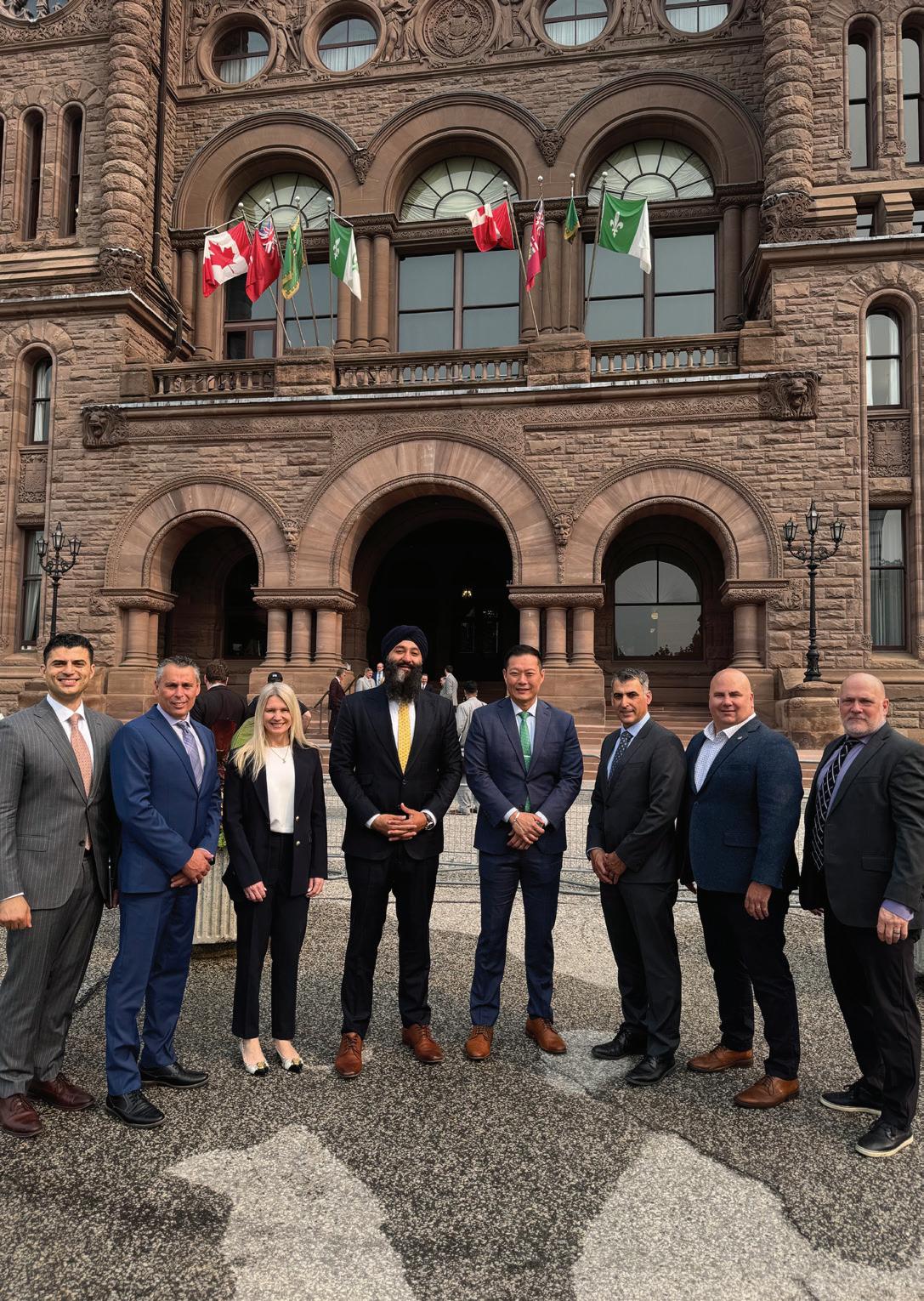

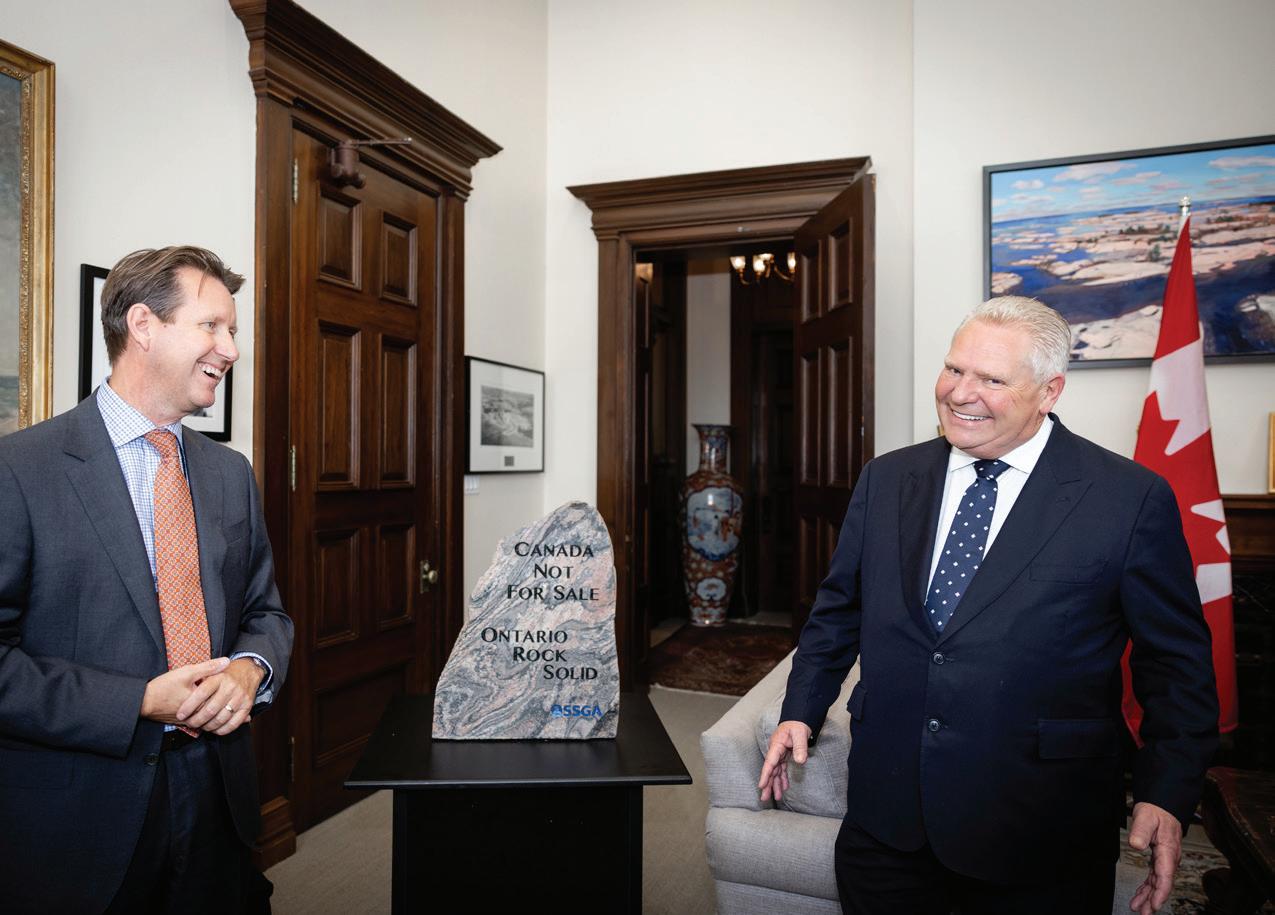

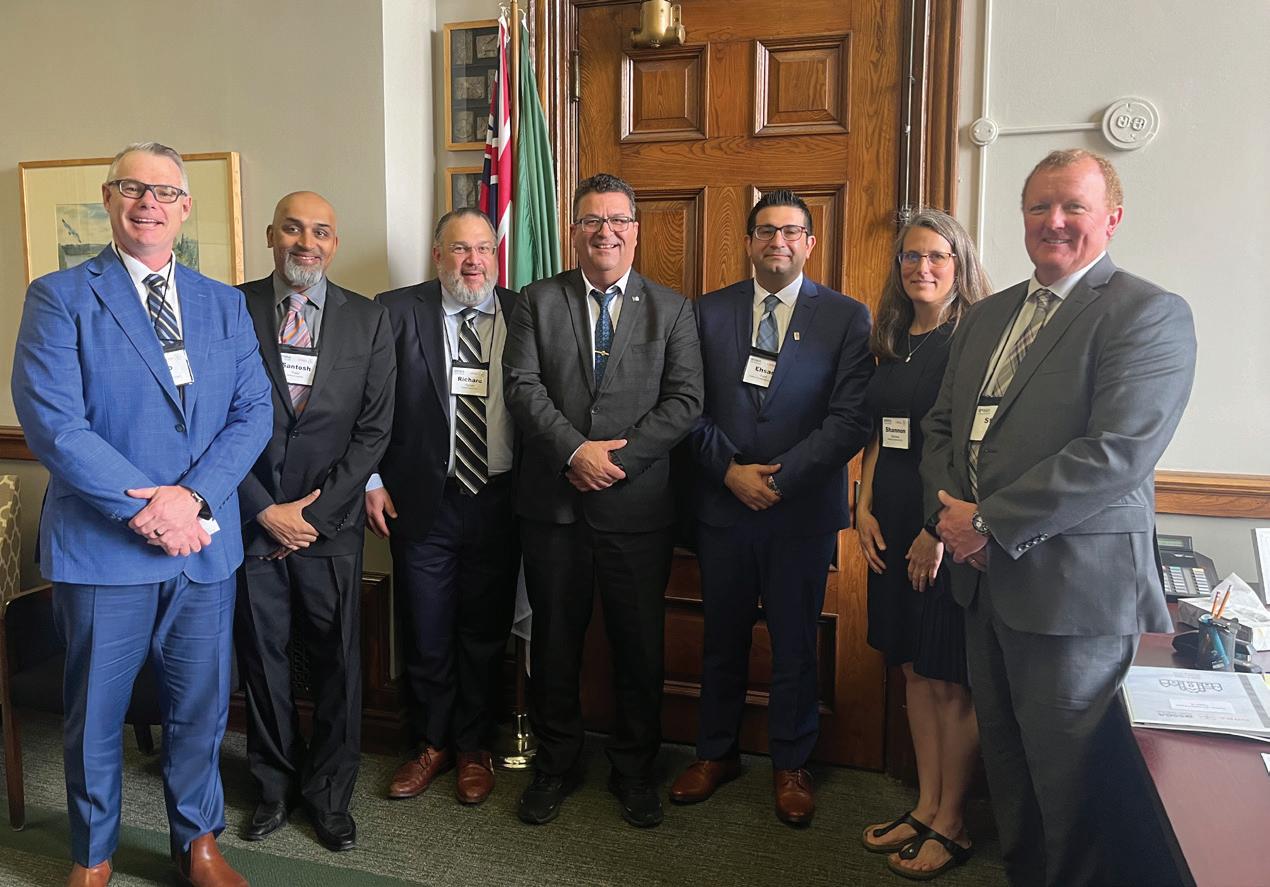
CLEARING THE WAY FOR INDIGENOUS ENGAGEMENT
BY MATTHEW BRADFORD
Canada's aggregate producers have long recognized the importance of respecting the lands and communities in which they operate. And as the industry works towards forging stronger and more meaningful relationships with its Indigenous partners, it's this same understanding that will lead to more impactful outcomes for all.
There are many reasons why Indigenous engagement has become a key process across the industries. First and foremost, it is a pillar of Canada's Truth and Reconciliation process, which aims to foster more equitable and reciprocal relationships with the 1.8 million Indigenous people who reside within its borders. Ontario, in particular, is home to the largest population of Indigenous people spread throughout 133 Indigenous communities. And as more and more industries take meaningful steps to consult, engage and even partner with Indigenous communities, they are finding that doing so is to everyone's advantage.
“It really can be a win-win between the industry and Indigenous communities,” says Michael Andrighetti, general manager at Ethier Sand and Gravel and treasurer of OSSGA. “By effectively engaging with them and supporting them, your project not only runs smoothly, but you're also building capacity in terms of creating local jobs and services. Those resources and local support can be especially important in northern and remote areas where it can be tough to attract workers”
Moreover, as long-time stewards of their lands, Indigenous partners often bring fresh insights and perspectives to the table. These, in turn, produce practices and approaches that enable miners, builders and aggregate producers alike to work more efficiently and sustainably.
Ultimately, adds John MacKay, president of Fowler Construction and chair of OSSGA, the goal of engagement isn't to simply “do the right thing” or check the box on a government directive: “The real goal of engagement is to build trust and mutual understandings, so both parties walk away wanting to work with each other. And when you engage respectfully and early, you gain alignment around shared values like protecting the environment, creating opportunities that benefit everyone.”
A challenge worth taking
In the aggregate sector, as in any industry, successful project outcomes are founded in Indigenous engagement. Yet, without clear and established frameworks in place to lead the way, the onus remains largely on individual companies to chart their own path.
There are many reasons why Indigenous engagement has become a key process across the industries. First and foremost, it is a pillar of Canada’s Truth and Reconciliation process, which aims to foster more equitable and reciprocal relationships with the 1.8 million Indigenous people who reside within its borders.

“Everyone wants to work with Indigenous communities and do what's right, but that can be difficult because there is no textbook strategy for creating these relationships, and no frameworks in place to create an expectation,” says Andrighetti.
Certainly, he adds, greater clarity and guidance can go a long way towards helping all parties – especially when it comes todefining who is included in engagement, how these processes should take shape and their expected outcomes. Nevertheless, the aggregate industry has been very proactive in this regard, and many OSSGA members are taking it on themselves to develop these relationships and put individual agreements in place. Clearer guidance is needed, but the work is being done.
The fundamentals of engagement
The path to building meaningful and lasting relationships with Indigenous communities looksdifferent for every company. But while approaches may vary, those who succeed share some common practices.
First and foremost, says MacKay, is to simply take the initiative: “Start [engagement] as early on in the process as you can. Even if you don't already know the Indigenous communities in your area, make that first handshake.”
Patience is also a virtue.These relationships don't happen overnight; they require time, trust and a genuineeffort to understand each community and its leadership, recognizing that each has its own identity and priorities. To that end, MacKay insists, “Transparency is key. From the start, you need to be clear about what the project will mean for the community. Share the details – like, for instance, whether it's 50 trucks a day or 100 – and keep those lines of communication open.”
Aggregate teams can also benefit by identifying how their local Indigenous community can contribute to a project, be it through local labour, subcontractors, services or resources. Recognizing a community’s potential – and what it needs to reach it – is key to forming partnerships and economic growth that thrive well beyond the project’s completion.
Internally, it is equally important to embed Indigenous relations into company culture. This can mean developing formal policies, creating dedicated Indigenous relations roles and investing in cultural training and education. What matters is that stakeholders at all levels understand the importance of Indigenous engagement and acknowledge that Indigenous people in Canada hold distinct rights and a voice in decisions about how and where infrastructure is developed.
Lastly, strong Indigenous partnerships are built with a long-term perspective. While delivering immediate benefits during aggregate operations is valuable, the ultimate goal is to support skills, capacity and opportunities that endure long after the project ends.
“At the end of the day, it’s about relationships,” says MacKay. “The goal should be a long-term partnership, not just a transaction.”
Setting the tone
The need for industries to consult with Canada's Indigenous people is far from new. Over the years, many companies have taken these mandates to heart, demonstrating what happens when engagement is approached with a true intent to benefit all.
“There are great examples of partnerships across Ontario that are working very well,” says Andrighetti. “And it’s not just about cutting cheques, either; they’re hiring local people, supporting community events and raising awareness for the issues that matter in Indigenous communities.”
“The aggregate industry is also doing a good job of this already,” he continues, “and the more we learn and improve, the more everyone benefits.”
On the path to Indigenous engagement, respect, commitment and authenticity count. The journey may not always be straightforward, but the long-term benefits for both communities and companies make it a worthwhile route to take.

We’re here to help you with: •Natural
•Pit and quarry license applications
•Site plan designs and amendments •Volume calculations

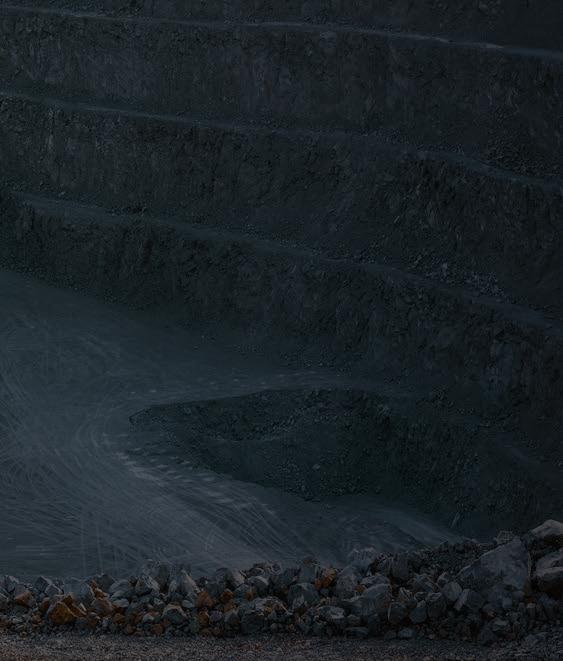
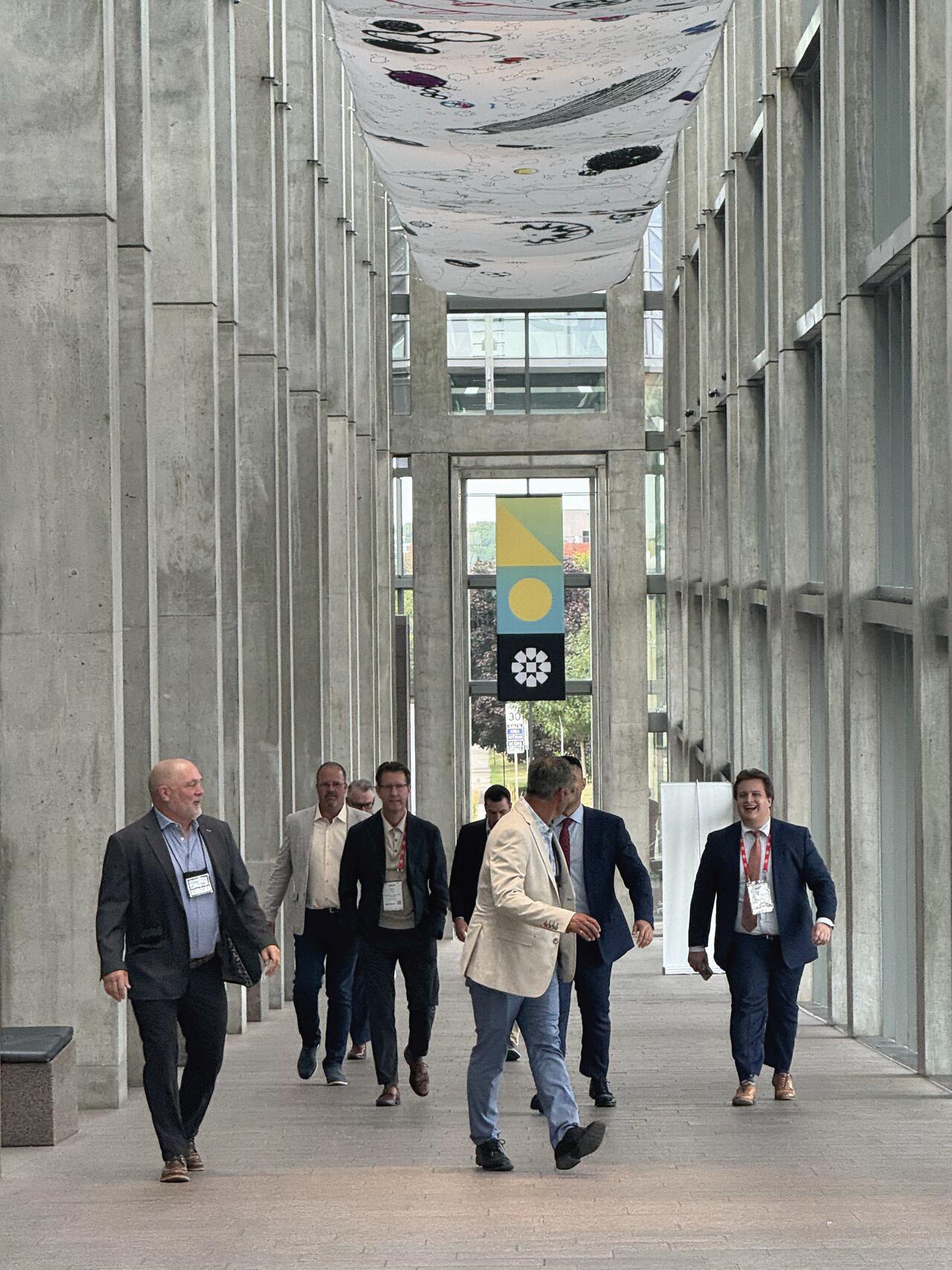
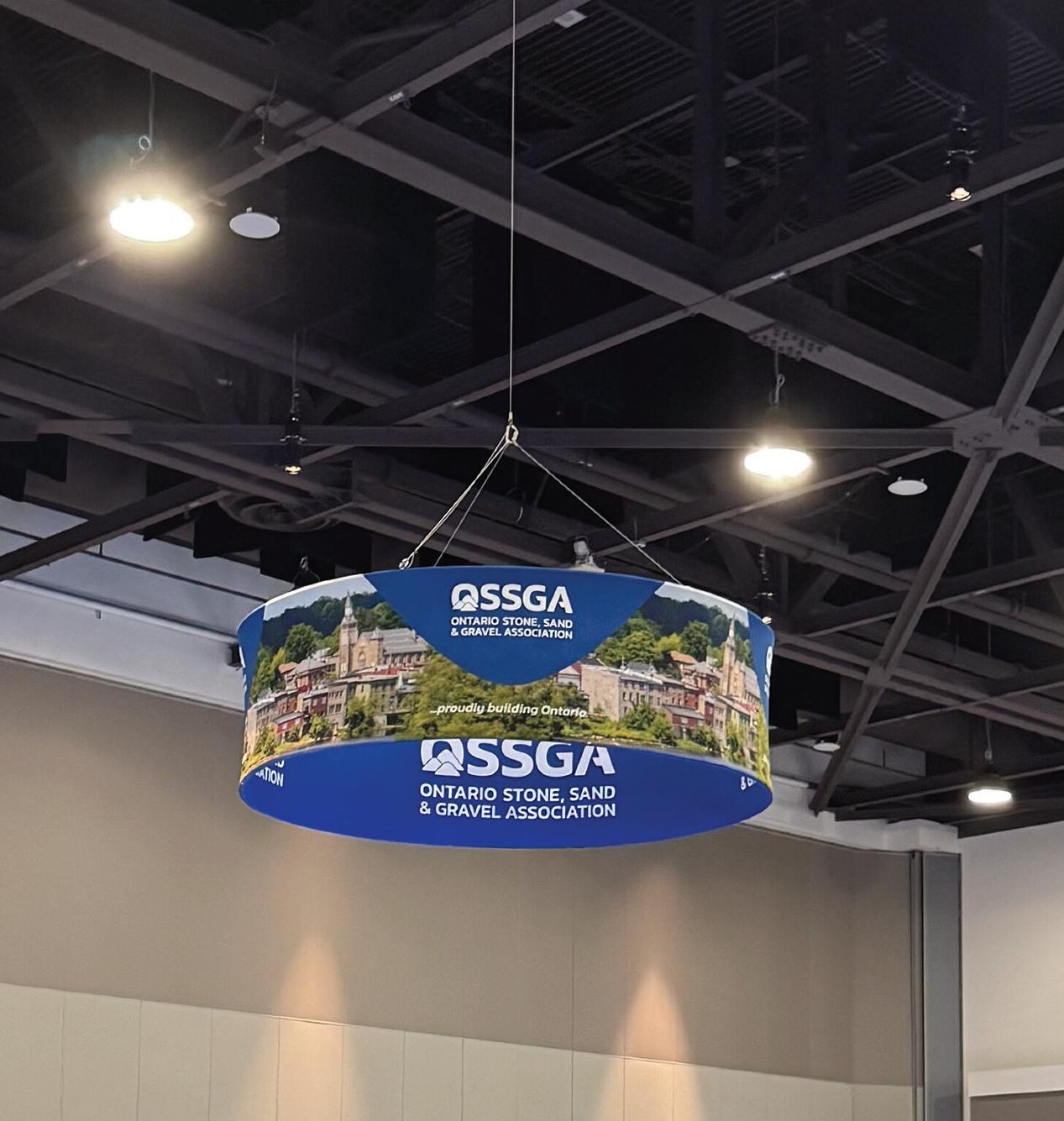

OSSGA marks major success at AMO infrastructure reception
BY OSSGA STAFF WRITER
OSSGA co-hosted a landmark Infrastructure Industry Reception at the AMO Conference in August, drawing more than 1,100 attendees. The event was held in partnership with ORBA, the Masonry Council of Ontario and the Cement Association of Canada. This reinforced OSSGA’s commitment to collaboration as one of the handful of events it has held with other industry associations this year.
The reception brought together municipal leaders, industry representatives and government officials to discuss Ontario’s infrastructure priorities and the essential role of construction materials in supporting growth. With housing and transit demands rising across the province, the event served as a timely reminder of the need for coordinated investment and planning.
OSSGA Executive Director Michael McSweeney said the reception was a clear demonstration of the sector’s commitment to collaboration. “We’re proud to stand alongside our partners to advocate for smarter infrastructure investment and stronger communities,” he said. “Nothing gets built without aggregate in Ontario, and with the province’s plans for growth we need to ensure that a sustainable supply is available where it’s needed most.”
The evening featured productive conversations and renewed partnerships, reinforcing the message that increased investment in infrastructure is a must for Ontario and the industry is ready to deliver. The strong turnout and engagement underscored the importance of maintaining open dialogue between municipalities and the materials sector.
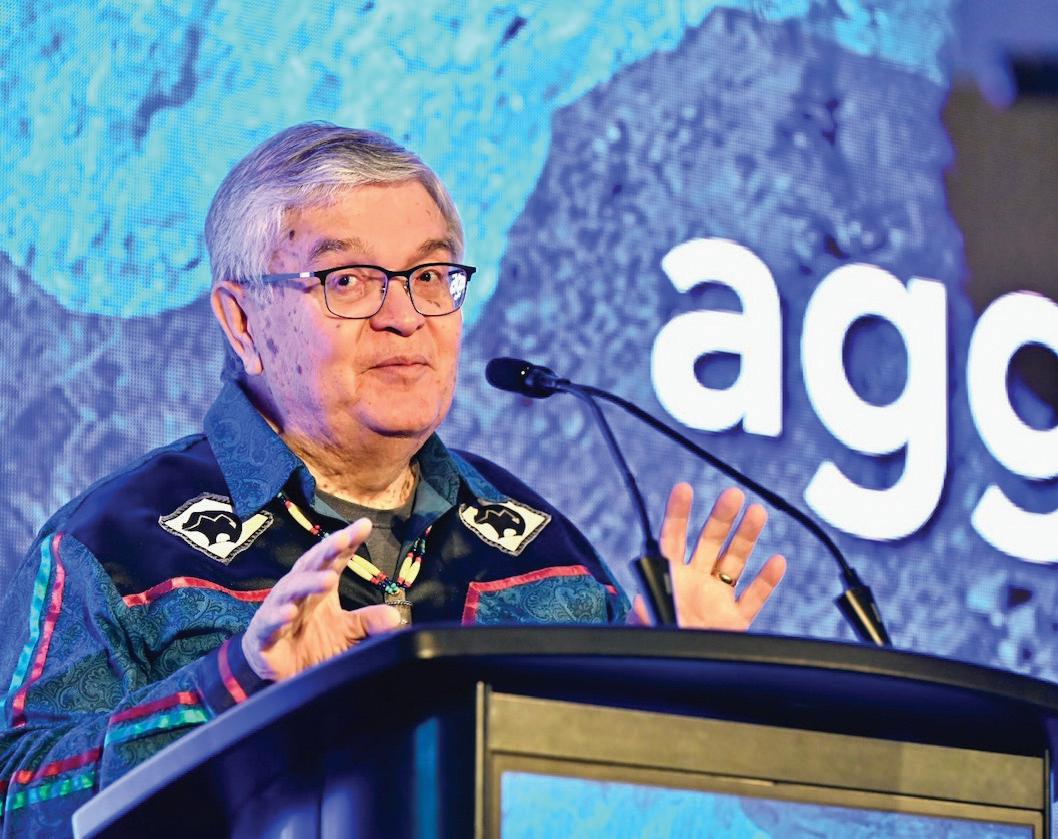



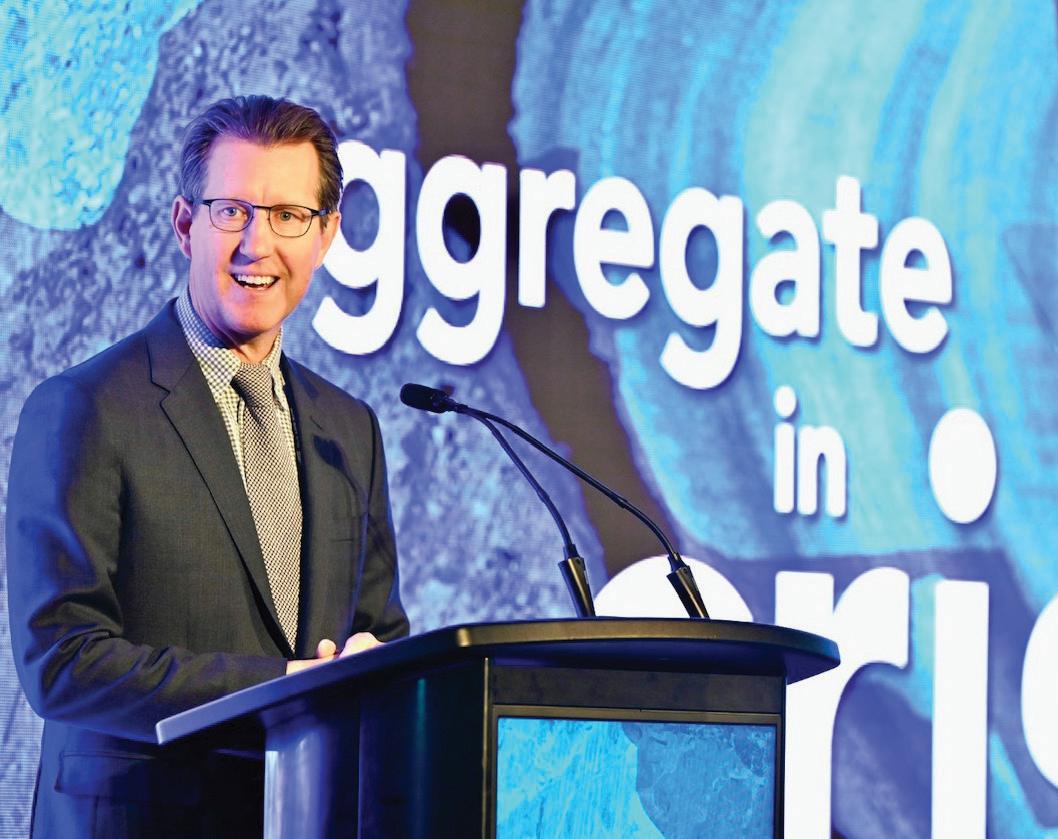
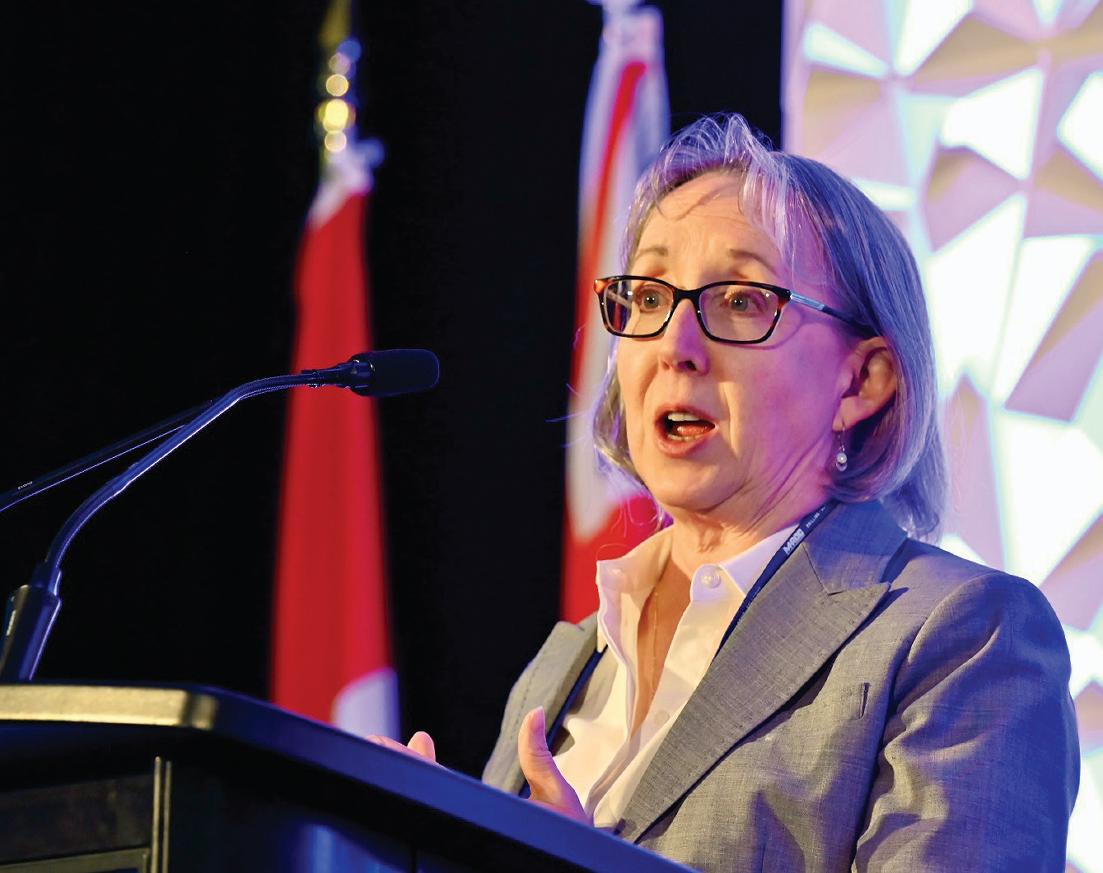
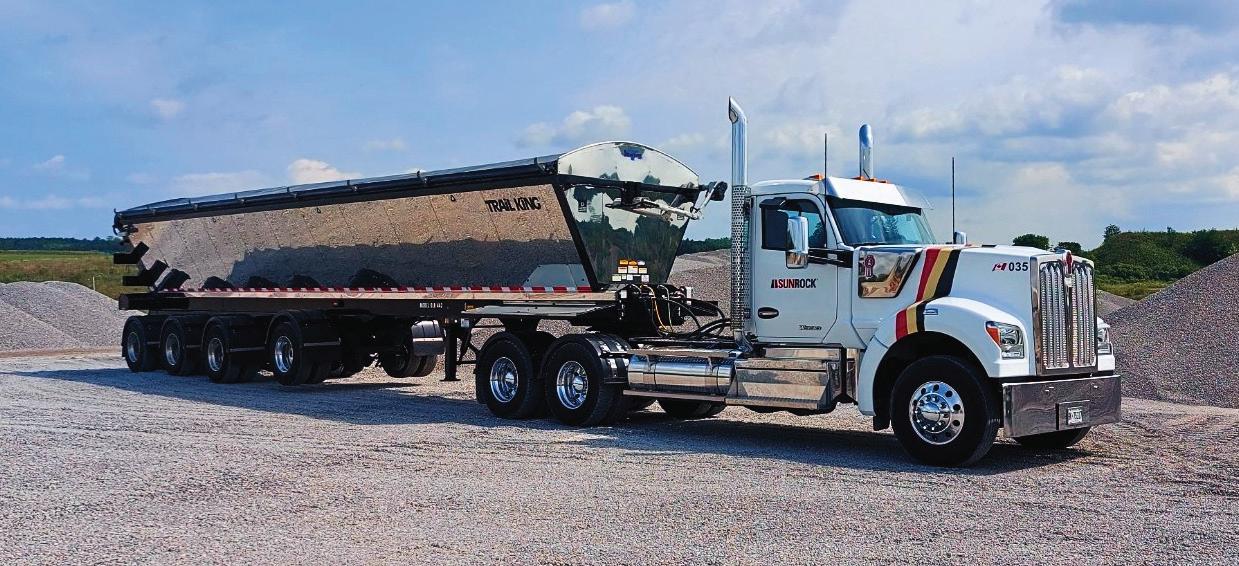


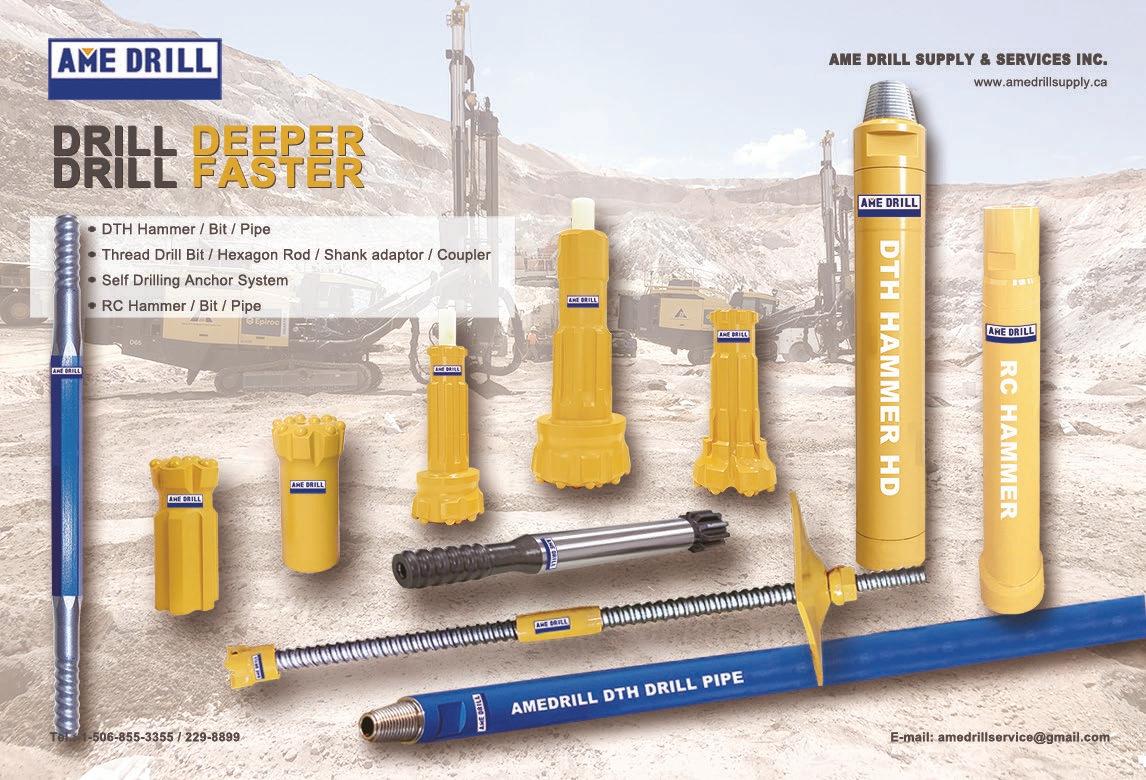
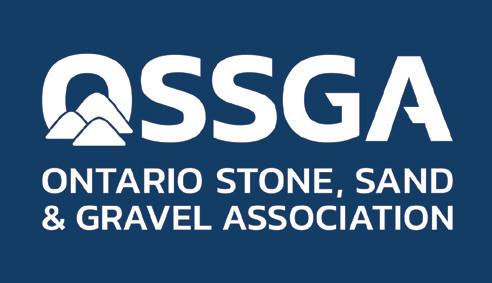
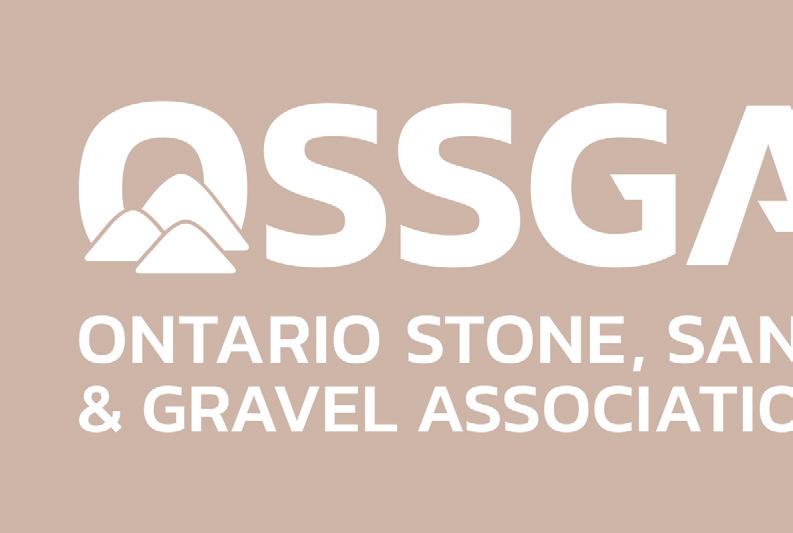






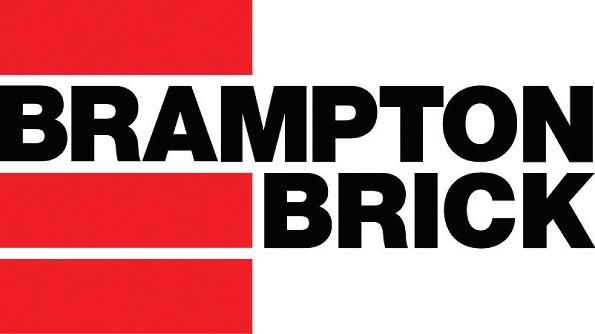





proud supporters of OSSGA

Automated Engineering Technologies Ltd.
Certified Engineering and Survey Technologists



AULT


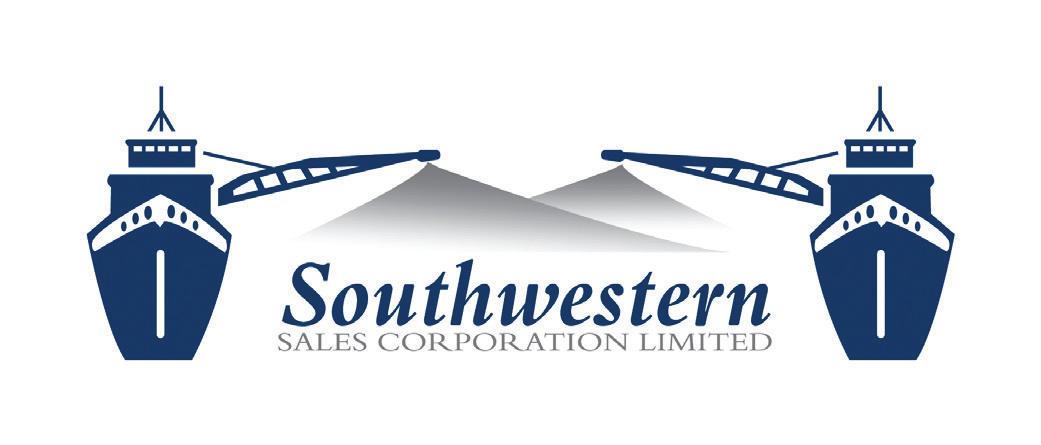



Following family tradition into the aggregate industry
We spoke with Lauren McKenzie, commercial customer service supervisor at Dufferin Aggregates, about her career journey in the aggregate sector and her passion for the work.

OSSGA: Tell us a bit more about your job and your responsibilities.
Lauren: I am currently the commercial customer service supervisor at Dufferin Aggregates. In this role, I oversee employees responsible for back-office billing, resales, royalties, as well as logistics team leads who manage scale house operations. Over my 11 years in the industry, I have held several positions including scale operator, soil operations, customer service supervisor, logistics supervisor and sales representative. Each of these roles has given me a well-rounded perspective on both the operational and customer-facing sides of the business.
Describe your typical day on the job and how the work you do contributes to the company.
No two days are exactly alike, which is one of the things I enjoy most about my job. A typical day involves supporting my teams in problem-solving, ensuring trucks are moving efficiently through our sites and making sure our billing and back-office processes are accurate and timely. I also work closely with customers, colleagues and team leads to address issues quickly and provide solutions. My role directly contributes to customer satisfaction and operational efficiency, both of which are critical to the success of the business.
What do you find most challenging in your work?
The most challenging aspect is the fast-paced environment and the need to make quick, informed decisions when unexpected issues arise. Whether it’s a logistics challenge, a customer concern or an operational hiccup, I need to stay calm under pressure and guide my team toward effective solutions.
What do you enjoy the most about your job?
I truly enjoy the people I work with and the constant variety in my day. The challenges keep me engaged and on my toes, and I love that no two days are ever the same. I also take pride in educating people about our industry — most people don’t realize how much aggregates contribute to their daily lives until you explain it.
How did you become interested in this field?
My father, Dwayne McKenzie (general manager at Nelson Aggregate) has always worked in the aggregate industry.
Lauren McKenzie, Dufferin Aggregates
What hard or soft skills should someone in your field have?
Key hard skills include understanding of logistics, operations and basic business/ financial principles. However, soft skills are equally important: communication, problemsolving, adaptability and teamwork are essential in such a fast-paced industry. Strong decision-making and customer service skills are also critical, as the work often requires balancing operational efficiency with customer satisfaction.
If you could start over, would you change your career path? If yes, how and why?
No, I wouldn’t change my career path. The aggregate industry may not seem glamorous from the outside, but it has given me so much and allowed me to build a fulfilling career. The mix of challenges, growth opportunities and people I’ve met along the way make me grateful for the path I’ve taken.
INDUSTRY AND ADVICE
What advice would you give a high school student unsure of the opportunities in the aggregate industry?
While I never set out thinking I would follow in his footsteps, I naturally found myself drawn to the work and the people. Over time, I developed a passion for the industry, and today I’m proud to be continuing the family tradition.
EDUCATION AND ADVANCEMENT
Is your current position the same as when you started in this company? If not, what steps did you take to advance your career?
No, my position has evolved significantly. I started as a scale operator at Nelson Aggregate before moving into soil operations and later becoming a customer service supervisor. When I joined Dufferin Aggregates in 2020, I began as a logistics supervisor, then advanced to sales representative and more recently stepped into my current role as commercial customer service supervisor. Each step came with new responsibilities, opportunities to lead and a willingness to learn from both experience and formal education.
What about your educational background? Has it impacted your role and career development?
When I transitioned into sales, I realized I needed additional education to complement my experience. Although I only had a high school diploma, I enrolled part-time in Fanshawe College’s General Business program and completed my diploma online in three years. My work experience made my schooling easier to relate to, and my schooling gave me stronger knowledge of finance, business processes and customer service strategy. I believe both education and hands-on experience are vital to success — education builds knowledge, while experience sharpens decision-making and problem-solving.
Don’t underestimate the opportunities in this industry. Many people assume aggregate means only hard, physical work, but there are so many different career paths — ranging from operations to sales, logistics, finance and customer service. I encourage students to give the industry a chance; you may find a role that aligns perfectly with your interests and strengths.
What are some common jobs in the aggregate industry that you do not need a formal education to apply for?
There are many entry-level opportunities such as scale operators, equipment operators, general laborers and logistics support staff. These positions allow you to get your foot in the door, learn the business from the ground up and decide if you want to pursue additional education or training to move into supervisory or specialized roles.
I started as a scale operator at Nelson Aggregate before moving into soil operations and later becoming a customer service supervisor. When I joined Dufferin Aggregates in 2020, I began as a logistics supervisor, then advanced to sales representative and more recently stepped into my current role as commercial customer service supervisor.


PROFESSIONAL SERVICES DIRECTORY
Inc. 24, 28
Hutcheson Sand & Mixes A member of the Muskoka Rock Family of Companies www.hutchesonsand.com 29 AGGREGATE & ROAD BUILDING


Skelton, Brumwell & Associates Inc.






















The Final Rehab DON VALLEY BRICK WORKS
Nestled in Toronto’s Don River valley, Don Valley Brick Works is a rare blend of industrial heritage and ecological renewal. Originally founded in 1889 as the Don Valley Pressed Brick Company, the site operated for nearly a century, producing bricks that built Toronto landmarks like Casa Loma, Massey Hall and Old City Hall.
The brick works was born from a chance discovery. While digging fence posts in the 1880s, William Taylor found high-quality clay. This led to the establishment of a quarry and brick plant that would become Ontario’s longest-running brick-making operation. Using clay, shale and water from nearby Mud Creek, the site employed three brick-making techniques — soft-mud, dry-press and stiff-mud — each technique tailored to different construction needs.
The company earned recognition for its quality, winning gold medals at the 1893 World’s Columbian Exposition in Chicago and the 1894 Toronto Industrial Fair. After the great fire of 1904, demand surged, and the brick works supplied much of the material used to rebuild downtown Toronto. By 1907, it was producing up to 100,000 bricks daily. The site later expanded, added electricity and introduced a sand-lime plant for interior bricks.
During the Great Depression, the site became a refuge for homeless men, and during the Second World War, German POWs worked there. By the 1980s, the clay was exhausted, and the site was sold and eventually expropriated for conservation in 1990 by the Toronto and Region Conservation Authority.
Today, Don Valley Brick Works is a thriving environmental and cultural hub. The rehabilitated quarry features ponds, meadows and trails, supporting diverse wildlife. The site also houses the Centre for Green Cities, farmers’ markets, art installations and educational programs.
Don Valley Brick Works stands as a testament to Toronto’s industrial past and its commitment to sustainable urban renewal. It received OSSGA’s Bronze Plaque Award in 2000.




